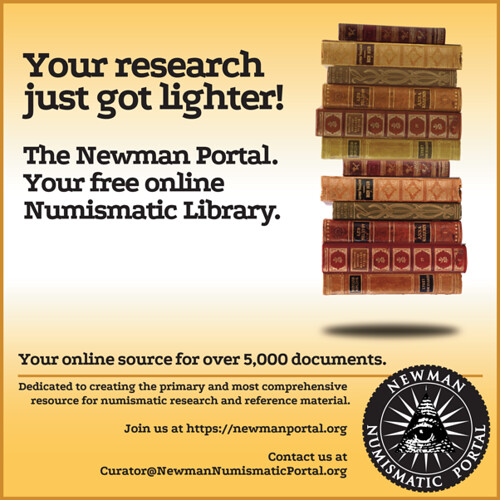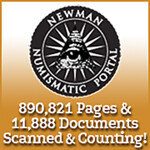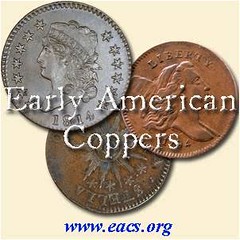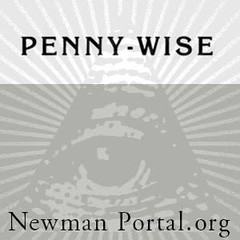
About UsThe Numismatic Bibliomania Society is a non-profit organization devoted to the study and enjoyment of numismatic literature. For more information please see our web site at coinbooks.org SubscriptionsThose wishing to become new E-Sylum subscribers (or wishing to Unsubscribe) can go to the following web page link MembershipThere is a membership application available on the web site Membership Application To join, print the application and return it with your check to the address printed on the application. Print/Digital membership is $40 to addresses in the U.S., and $60 elsewhere. A digital-only membership is available for $25. For those without web access, write to: Terry White, Treasurer AsylumFor Asylum mailing address changes and other membership questions, contact Terry at this email address: terrywhite5475@yahoo.com SubmissionsTo submit items for publication in The E-Sylum, just Reply to this message, or write to the Editor at this address: whomren@gmail.com
BUY THE BOOK BEFORE THE COIN |
- WAYNE'S WORDS: THE E-SYLUM MARCH 5, 2017
- ASYLUM SPRING 2017 ISSUE PUBLISHED
- KOLBE & FANNING BUY OR BID SALE THROUGH MARCH 15
- CNG OFFERS NUMISMATIC LITERATURE IN E-SALE 393
- NEW BOOK: COINS, ARTISTS, AND TYRANTS
- NEW BOOK: PUNCH-MARKED COINS OF EARLY INDIA
- MORE ON COLONIAL ARCHAEOLOGIST NOëL HUME
- NEWMAN PORTAL USER FORUM AT CSNS CONVENTION
- COLLECTIVECOIN.COM ACQUIRED BY STACK’S BOWERS
- MORE ON AMERICA’S FIRST MEDALS
- NOTES FROM E-SYLUM READERS: MARCH 5, 2017
- THE 1917-1919 SUSPENSION OF U.S. GOLD COINS
- OLGA KORBUT'S OLYMPIC MEDALS SOLD
- VOCABULARY TERM: LUNETTE
- CHARLES FREDERICK GüNTHER (1837–1920)
- 1948 VIEW OF CALIFORNIA FRACTIONAL GOLD
- BOSTON CLUBS SPONSOR 2017 ROCKWELL LECTURE
- QUERY: WHO MADE THIS MARYLAND MYSTERY PLAQUE?
- MORE ON THE BUTLER COLORED TROOPS MEDAL
- NUMISMATIC NUGGETS: MARCH 5, 2017
- SELECTIONS FROM STACK'S BOWERS MARCH 2017 SALE
- MAN ARRESTED CARRYING ANCIENT COINS INTO ISRAEL
- MCDONALD'S FEATURES AN ANCIENT ROAD
- DETECTORIST FINDS RARE GOLD ANGEL OF EDWARD V
- CURIOUS UNDERWEIGHT 1983 CENT FOUND
- ANOTHER CALL TO END U.S. CENT PRODUCTION
- THE 1976 U.S. BICENTENNIAL COINAGE
- A MYSTERY UNITED NATIONS GOLD PATTERN
- QUERY: 1896 ARGENTUM UNIVERSALE ISSUES
- SOUTH AFRICA "ZULU" MEDAL BRINGS RECORD PRICE
- BEWARE OF HOBO NICKEL COPIES
- STOP AND SMELL THE BOOKS
- THE OLDEST U.S. LETTERPRESS TYPE FOUNDRY
Click here to access the complete archive
To comment or submit articles, reply to whomren@gmail.com
Content presented in The E-Sylum is not necessarily researched or independently fact-checked, and views expressed do not necessarily represent those of the Numismatic Bibliomania Society.
WAYNE'S WORDS: THE E-SYLUM MARCH 5, 2017
New subscribers this week include: William Bigler, courtesy of Ralph Winter, Alan Stullenbarger, courtesy of Pat McBride; and Ron Sirna. Welcome aboard! We now have 2,731 subscribers.
Thank you for reading The E-Sylum. If you enjoy it, please send me the email addresses of friends you think may enjoy it as well and I'll send them a subscription with your compliments. Contact me at whomren@gmail.com anytime regarding your subscription, or questions, comments or suggestions about our content.
This week we open with a new issue of our print journal, literature sales from Kolbe & Fanning and CNG, two new books, and more on colonial aechaeologist Noël Hume.
Other topics this week include the 1917-1919 suspension of U.S. gold coin production, collector C.F. Günther, the Butler Colored Troops medal, a rare gold angel of Edward V, the 1976 bicentennial coinage, the "Zulu" medal and copies of Hobo Nickels.
To learn more about Dr. John A. Muscalus, John Drury, punch-marked coins of India, the next Newman Numismatic Portal user forum, Arabic numeral dates, lunette medals, the Cracker-Jack King, the 1856 "Buck-Cannon" campaign medal, the "United States 'Talent' " of 1896 and shaving in the Old treasury Vault, read on. Have a great week, everyone!
Wayne Homren
Editor, The E-Sylum
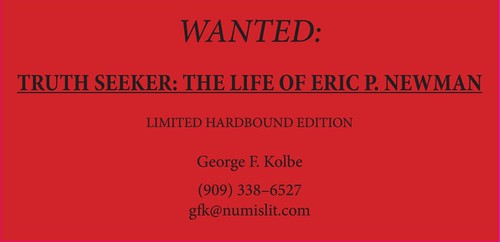
ASYLUM SPRING 2017 ISSUE PUBLISHED
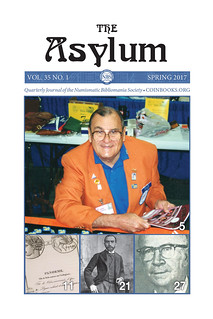 The Asylum Spring 2017 v35 n1
The Asylum Spring 2017 v35 n1
Table of Contents
Fred Lake: A Bookseller’s Retrospective by Alan Workman
ASSOCIATIONS: Autographs • Annotations • Inscriptions: Numismatique du Voyage du Jeune Anacharsis by Joel J. Orosz
Some Important Collectors of Ancient Coins in the 20th Century by Shanna Schmidt
Off the Shelf: Monographs on Paper Money by Dr. John A. Muscalus by David F. Fanning
The Numismatic Book Catalogues of John Drury by David F. Fanning
From the Editor
Happy New Year NBS members! As we begin a new year I want to thank everyone who has made my first year as editor of The Asylum a productive and pleasant one. We have had great contributions from many members—both new writers and old favorites—and I want to urge everyone to consider contributing an article on their own passion this year.
This first issue of 2017 contains a few firsts: we welcome new contributor Alan Workman, who sent us a wonderful remembrance of fellow numismatic bibliopole Fred Lake. Fred did so much for the hobby and we are saddened by his loss. We are so grateful to be able to share his memories of his friendship with Fred and for the photos of Fred throughout his life.
Prolific contributor Joel Orosz has begun a new occasional column called “ASSOCIATIONS: Autographs, Annotations, Inscriptions” which explores interesting association copies of numismatic books, reminding us that books are historical artifacts as well as being treasuries of information. Shanna Schmidt returns to share her research on several important 20th century collectors of ancient coins, and David Fanning revisits and expands on the bibliography of Dr. Muscalus in his “Off The Shelf” column.
I would also like to include a quick reminder to renew membership in the NBS to make sure you don’t miss any issues. Your expiration date is included on your mailing label and information can be found on renewing on page 3 of this issue or on our website at coinbooks.org.
As always, please feel free to contact me at nbseditor@gmail.com with any ideas for articles in the coming year and to give me a heads-up if you’re planning one so we can fill out our editorial calendar. Have a wonderful 2017
To join NBS or renew your annual membership, see:
www.coinbooks.org/about/membership.html
Jeff Reichenberger writes:
With the arrival of the Spring issue of The Asylum, I’d like to say, “hats off”’ to the NBS, and particularly it’s publications and editors. The Esylum and The Asylum just keep cranking out engaging issues. Many Thanks!
KOLBE & FANNING BUY OR BID SALE THROUGH MARCH 15
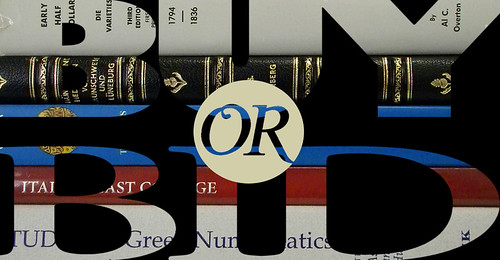
Kolbe & Fanning Numismatic Booksellers have announced their third “Buy or Bid Sale,” which begins now and will close on Wednesday, March 15. The sale focuses on modestly priced books, giving collectors an opportunity to add to their libraries at minimal cost.
There will be no printed catalogue. The PDF catalogue is available now for downloading from the Kolbe & Fanning website at numislit.com.
As the name of the sale suggests, customers may bid on items they wish to acquire or buy them outright at the published price. The Terms of Sale will give full instructions on how to participate: please read it carefully. This is the first “Buy or Bid Sale” we have held since 2013. We intend to hold them regularly from now on.
The sale includes over 1400 works on ancient, medieval and modern coins, as well as general works, periodicals and sale catalogues. “Buy” prices have been kept low to promote sales. To further encourage participation, the firm is offering free domestic shipping to bidders spending at least $500; there will also be no packing and processing fee for this sale. Again, please read the Terms of Sale before participating.
If you have any questions about the sale, please write the firm at orders@numislit.com.
Thank you in advance for your participation. Download the sale today: numislit.com.

CNG OFFERS NUMISMATIC LITERATURE IN E-SALE 393
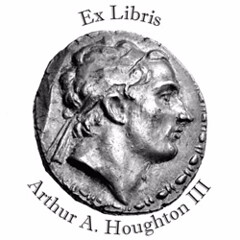 Books from the Libraries of Arthur A. Houghton III and J. Eric Engstrom with Duplicate Auction Catalogs from
the American Numismatic Society Featured in CNG E-Sale 393.
Books from the Libraries of Arthur A. Houghton III and J. Eric Engstrom with Duplicate Auction Catalogs from
the American Numismatic Society Featured in CNG E-Sale 393.
Classical Numismatic Group Electronic Auction 393, an online auction closing on March 15, 2017, features approximately 297 lots of books and other numismatically-related references, including a substantial offering from both the Arthur A. Houghton III and J. Eric Engstrom Libraries, as well as a second selection of duplicate auction catalogs from the Library of the American Numismatic Society.
The Arthur A. Houghton III library specialized in materials related to the study of Seleukid coins and contains a number of items of particular interest to that field, including an antiquarian copy of the Matthew Duane collection, published in 1803, a specially-bound copy of Arthur's first volume of his published collection [CSE], and an original copy of Ars Classica I, the sale of the Pozzi Collection in 1921.
As a well-known collector and numismatist, several association copies of works by other major numismatists are also offered, inscribed by the authors to Arthur. The lots from the J. Eric Engstrom Library consist of volumes of Numismatic Notes and Monographs, published by the American Numismatic Society. Rather than offering them as a single lot, these volumes are offered thematically, so that collectors in those specialized fields may have an opportunity to acquire pertinent volumes in their specialized fields.
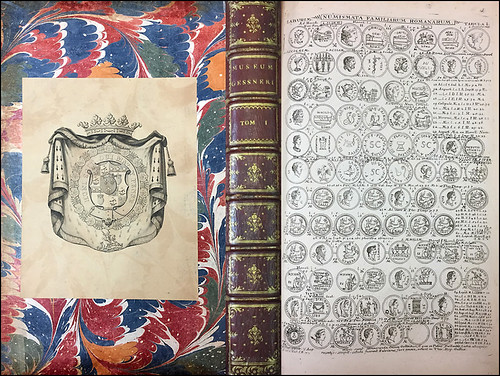
In addition to the Duane volume, the book portion also includes a rare copy of Francesco de Ficoroni's I piombi antichi. Opera di Francesco De Ficoroni dedicata alla santita di Nostro Signore papa Benedetto XIV, and Johann Jacob Gessner's 1738 Specimen rei nummariæ, cum prolegomenis et amplissima veterum numismatium collectione, as well as a 2010 Folio Society reprint edition of David Roberts' 1849 THE HOLY LAND and EGYPT AND NUBIA.
The sale of duplicates from the Library of the American Numismatic Society is CNG’s second offering (the first was in Electronic Auction 371), allowing collectors to supplement their reference libraries with some earlier, hard-to-find sales of some of the major firms of the past century or more.
For more information, see:
http://cngcoins.com/

NEW BOOK: COINS, ARTISTS, AND TYRANTS
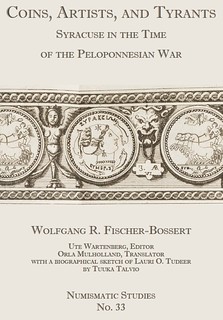 Coins, Artists, and Tyrants: Syracuse in the Time of the Peloponnesian War
Coins, Artists, and Tyrants: Syracuse in the Time of the Peloponnesian War
(Numismatic Studies 33)
by Wolfgang R. Fischer-Bossert
Ute Wartenberg, Editor
with selected passages from L. O. Tudeer,
Die Tetradrachmenprägung von Syrakus in der Periode der signierenden Künstler
translated by Orla Mulholland,
and a biographical sketch about Tudeer by Tukka Talvio
SPECIAL PRE-ORDER PRICE: US$120.00
Shipping will be billed separately upon posting.
(valid until April 1, 2017)
List price: $200 plus shipping & handling
Member price: $140 plus shipping & handling
ISSN 0517-404-x
ISBN 978-0-89722-341-6
Hardcover, 400 text pages, b/w figures, 27 b/w plates, hoards pull-out, signed tetradrachms pull-out, color die-link chart pull-out
Coins, Artists, and Tyrants contains the first fully translated and revised text of Lauri O. Tudeer, Die Tetradrachmenprägung von Syrakus in der Periode der signierenden Künstler, as well as a biography of Tudeer, plus a completely new evaluation of signed coin dies and the artists who produced them. Over 100 years after its first publication, Wolfgang R. Fischer-Bossert completely updates the scholarship and bibliography on signed Syracusan tetradrachms, making this book the single most important source on the subject. The book includes plates, a full-color die-link chart, and three pull-outs featuring Syracusan tetradrachms and hoards.
Wolfgang R. Fischer-Bossert is an independent scholar specializing in Archaic and Classical coinages of the Greeks including their barbarous neighbours in both the Balkans and the Levant. He has been on the staff of the German Archaeological Institute at Athens and has also worked with the excavation teams at Boğazköy-Hattuša and Karatepe/Cilicia in Turkey. He has published widely, and has taught Classics and Ancient Numismatics at the Freie Universität, Berlin, and at Vienna University. He currently holds a post-doc at the Austrian Academy of Sciences, Institute for the Study of Ancient Culture.
For more information, or to order, see:
Coins, Artists, and Tyrants: Syracuse in the Time of the Peloponnesian War
(http://numismatics.org/store/tudeer/)
NEW BOOK: PUNCH-MARKED COINS OF EARLY INDIA
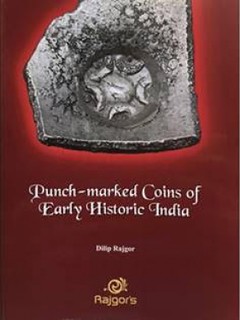 Punch-marked Coins of Early Historic India chronicles 200 years of numismatic history of the indian sub-continent. The period covered in the monograph ranges from the rise of janapadas (states) in c.600 BC to the rise of the Shishunagas in c. 400 BC.
Punch-marked Coins of Early Historic India chronicles 200 years of numismatic history of the indian sub-continent. The period covered in the monograph ranges from the rise of janapadas (states) in c.600 BC to the rise of the Shishunagas in c. 400 BC.
Authors (s): Dilip Rajgor (Author)
Format: Softcover
Pages: 221p., Plates 16 and Illustrations 289 Coins.
Pub. date: 27.02.2017, 2nd. Reprint.
Publisher: Rajgors
Language (s): English
Bagchee ID: BB106598
List price: US $ 110,00
Bagchee price: US $ 99,00
For more information, or to order, see:
Punch-Marked Coins of Early Historic India
(www.bagchee.com/books/BB106598/punch-marked-coins-of-early-historic-india)
THE BOOK BAZARRE
MORE ON COLONIAL ARCHAEOLOGIST NOëL HUME
E-Sylum contributor Erik Goldstein is the Senior Curator of Mechanical Arts & Numismatics at the Colonial Williamsburg Foundation. Regarding the passing of Noël Hume, former director of archaeology at Colonial Williamsburg, Erik writes:
When our expanding family left the New York City area for Virginia in 2001, I knew I was bringing myself nearer to an entity I yearned to become a part of – the community of curators, tradesmen, museum professionals, and archaeologists who bring the Williamsburg-Jamestown-Yorktown ”Historic Triangle” to life. Once I joined the team at Colonial Williamsburg, I had the chance to meet and befriend many of the greats in the diverse fields of early American historical studies.
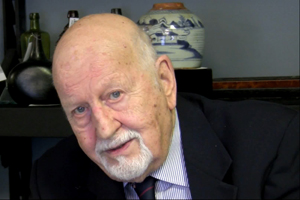 Shortly thereafter, I was invited to show up at the monthly meeting of the local archaeological club, which then met at a British pub, of course. At the head of a long table populated by pint glasses and dusty archaeologists fresh in from “the field,” sat Ivor Noël Hume (just Noël, to his friends), a celebrity I had hoped to meet since I was in college. Like the big-mouthed putz that I am, I giddily introduced myself, and proceed to tell Noël that he had wrongly identified a very important military object excavated from the yard of Wetherburn’s Tavern in 1965. NOT a good idea at all!
Shortly thereafter, I was invited to show up at the monthly meeting of the local archaeological club, which then met at a British pub, of course. At the head of a long table populated by pint glasses and dusty archaeologists fresh in from “the field,” sat Ivor Noël Hume (just Noël, to his friends), a celebrity I had hoped to meet since I was in college. Like the big-mouthed putz that I am, I giddily introduced myself, and proceed to tell Noël that he had wrongly identified a very important military object excavated from the yard of Wetherburn’s Tavern in 1965. NOT a good idea at all!
Perhaps the only thing which saved me was the fact that I had a good working knowledge of two areas of early American “material culture” studies that he loved, but wasn’t as well-versed in as he wanted to be; numismatics and the British military. My initial misstep aside, we quickly became good friends when it became apparent the we were both voracious collectors of all sorts of historical stuff. I earned a standing invitation to his house, where we would meet, usually on a Friday afternoon.
Since he had some difficulty in getting around, we only ever met at my house once. Depending on where our ongoing conversation was focused at the moment, I would show up with a coin, a sword, a bottle (empty & old) or even a musket for detailed examination and discussion. In addition to chatting about the antiquities around us, we spent many hours discussing the ethics of our respective professions, and the implications and pitfalls of those who dared to collect what they studied, excavated, or cared for. Never shy with his opinion, he vehemently defended the private collector, seeing relics of mankind’s past as property of mankind, not just those inside the museum and academic worlds. For this, and a whole bevy of other reasons, Noël was one of my heroes, a tremendous influence, a mentor and a friend.
John Kraljevich adds:
I got a little misty eyed. Meeting Noel remains one of the highlights of my life.
Thanks, guys. Sorry for the loss; Noël Hume was one of the greats of the field.
I'm a big proponent of the private collector as well. Museums are great and wonderful things, but they can't be everywhere or collect everything; the private sector nicely complements the public sector, whether all of their employees and boosters understand that or not. -Editor
To read the earlier E-Sylum article, see:
COLONIAL ARCHAEOLOGIST NOëL HUME
(www.coinbooks.org/v20/esylum_v20n09a10.html)
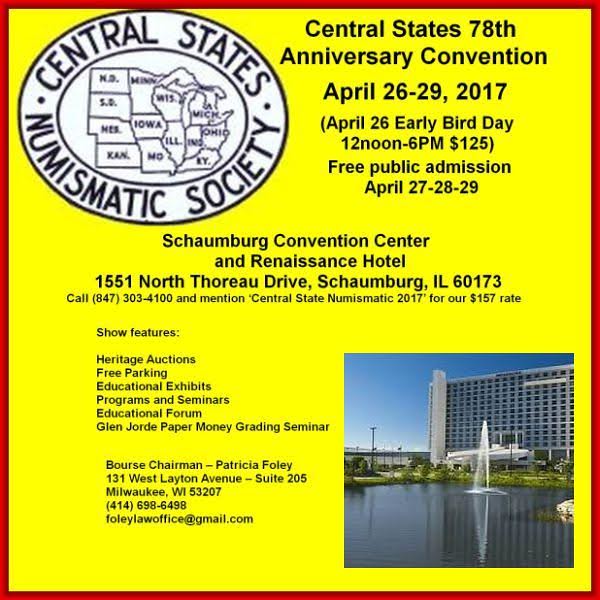
NEWMAN PORTAL USER FORUM AT CSNS CONVENTION
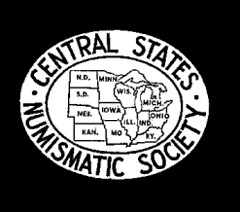
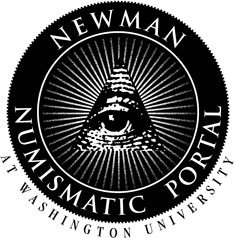
The Newman Portal will host a user forum at the Central States show, Thursday, April 27, at the Renaissance Convention Center. This event will be held from 11AM – 1PM in the Serendipity Room. Lunch is included. We will present current status of the Newman Portal, including upcoming features and new content, and solicit user feedback on future direction. Admission is free, but please reserve a spot via email to Len Augsburger, Newman Portal Project Coordinator, at leonard.augsburger@wustl.edu. A similar event at Baltimore in November filled quickly, so please let us know as soon as possible if you wish to attend.
To visit the Newman Numismatic Portal, see:
www.newmanportal.org
The Baltimore event was immensely enjoyable and quite productive. I'll be at the Central States event as well. We're looking forward to meeting with new and existing users of the portal, as well as representtive of organizations interested in hosting their club's publications on the site for the benefit of their members and the larger numismatic community.
Here's an excerpt from my November 6, 2016 Numismatic Diary to give the flavor of the event. -Editor
Counting some latercomers, we had about 24 in attendance, including Bruce Smith, Allan Schein, Roger Burdette, Jeff Rock, Erik Goldstein of Colonial Williamsburg, Andy Newman, Maureen Levine, Roger Moore, Jim Glickman Terri Venresca, Gamal Amer and American Numismatic Society Librarian David Hill. After we ordered our lunches, Len opened with a presentation, then I got up to give a deeper dive on some key topics including using the hierarchical menus vs. search terms, the "front end" vs. "back end" (Internet Archive), in-copyright vs. out-of-copyright works, and third-party content vs. content written or curated by NNP.
Jeff Rock opened a discussion of the impacts on the market for out of copyright numismatic literature. Andy Newman answered questions about the origin of the Newman Portal idea, and Eric's strong support for making numismatic information widely and freely available. We closed with some great stories about Eric. I noted that if it had been the evening and we all had drinks in our hand, I'd raise a glass for a toast thanking Eric for his gift to the hobby. We closed with a round of applause and a lengthy to-do list of ideas for new content and software features.
Here are some pictures.
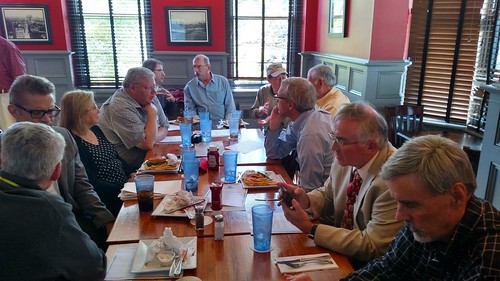
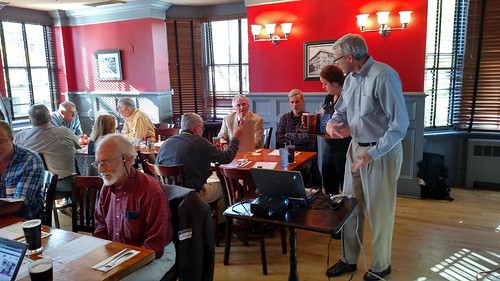
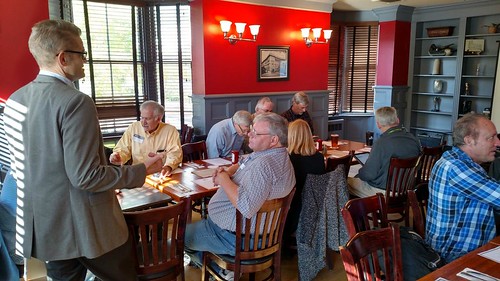
To read the earlier E-Sylum article, see:
WAYNE'S NUMISMATIC DIARY: NOVEMBER 6, 2016
(www.coinbooks.org/esylum_v19n45a16.html)

COLLECTIVECOIN.COM ACQUIRED BY STACK’S BOWERS
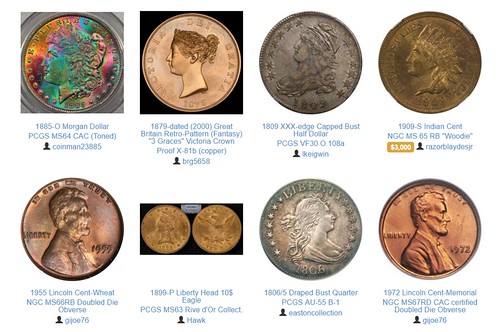
Stack’s Bowers Galleries is pleased to announce it has acquired the interactive website CollectiveCoin.com.
CollectiveCoin.com was started in 2014 by Matt Lenore and Nick Baum and is a leading tool for managing coin collections online, allowing collectors to publicly or privately view, manage and track their numismatic collections seamlessly across all devices. The website also has robust interactive social tools, allowing members to share their collections, to comment on individual coins or collections and to buy, sell and trade with other members.
“One of our mission statements is to provide solutions for all our clients’ collecting needs,” stated Brian Kendrella, company president. “Increasingly, collectors are looking for convenient technology solutions to manage and track their collections. We found no other technology that can offer this kind of utility for our clients and we look forward to expanding on its features and growing the member base.”
“With most collections these days stashed away in safe deposit boxes, collectors are eager to have digital records and manage and share online as the most convenient and safest way to enjoy their collections. I think it is a perfect match. Stack’s Bowers Galleries recognizes the benefits of CollectiveCoin.com and wants to expand the audience that truly enjoys the site’s benefits,” remarked Matt Lenore, co-founder.
The site has a tremendously loyal and committed user base and this base is expected to grow when CollectiveCoin.com is introduced to Stack’s Bowers Galleries’ worldwide users. “There are no immediate plans to change the site, but longer term we will integrate the site and its tools into StacksBowers.com, allowing users to seamlessly add all their SBG auction purchases as well as acquisitions from other sources. The site will also be expanded to include currency collections,” commented Kendrella. “The site is open for use during our transition and we welcome comments and suggestions.”
To visit the CollectiveCoin site, see:
https://collectivecoin.com/

MORE ON AMERICA’S FIRST MEDALS
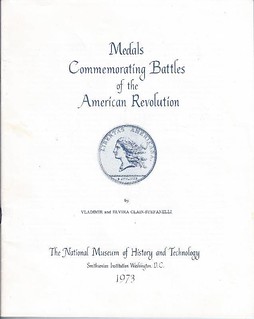 I have a set of the medals with the printed booklet.
I have a set of the medals with the printed booklet.
The Slip cover (white cardboard) and the Folder (blue) both have “The United States Mint” on them.
The documentation in the folder does not have any production figures or cost. However the 1974, 1975 and 1976 Annual Reports of the Director of the Mint did have some information.
The medals are made of antiqued finished pewter and were first available in sets of two at the price of $10, starting April 1 1974.
The album became available to order on April 8th, 1976, also included the 46 page booklet for the price of $5. In addition the album also came with an additional medal “Department of the Treasury”, making a total of 11 medals in the set. I find no information in the mint reports regarding the treasury medal.(maybe it was just an added bonus?)
The 1976 Annual Reports states that in total “approximately 2,354,000 medals were sold”, There could be as many as 158,000 sets possible (based on the lowest mintage medal), but the total must be less than that since they were initially offered as sets of two for $10. I am sure not everyone completed a set. The period to order the medals and album came to a close on June 25, 1976.
The series of antique-finished pewter America’s First Medals were minted by the San Francisco mint as part of the build up to the Bi-Centennial Celebration. An outstandingly researched and written discussion of everything about these medals was issued by John W, Adams and Anne E. Bentley in their Comitia Americana and Related Medals in 2007. As for particulars the mint printed announcement says in part the following:
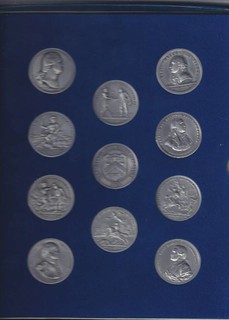 “These medals will be enclosed in a see-through plastic capsule inserted in a case surrounded by red flocking. The case is approximately 3 ½” by 2 ¾” with the Great Seal appearing on the cover. It is not only a holder for America’s first medals but also a self-display case which both sides of the medal can be viewed.
“These medals will be enclosed in a see-through plastic capsule inserted in a case surrounded by red flocking. The case is approximately 3 ½” by 2 ¾” with the Great Seal appearing on the cover. It is not only a holder for America’s first medals but also a self-display case which both sides of the medal can be viewed.
The first two medals of the series are being offered as a unit at $10.00 and may not be purchased separately. Each individual may purchase a maximum of five units and orders should be received no later than May31, 1974. Anyone who purchases the current offering will receive an order card when the next items in the series become available.
The ten-medal series will be completed by July 4, 1976, and the first two medals are available:”
Somewhere along the way the presentation holder with cardboard slip cover was offered with the detailed descriptive booklet and an eleventh medal – the Department of the Treasury 1789 medal that is at the center for $5.00. For medal collectors on a tight budget this pewter series was/is a great way to share some of the excitement of that period. I got a set with presentation holder for $55. As with most mint products the after-market prices dropped, partially because it was a pewter series and partially it was a medal series versus coins. I saw completes sets selling for $10-$20 25+ years later. In comparison, the Adams & Bentley “the reference” on the series initially sold for $135 in 2007 and you need reasonably deep pockets for any of the actual medals, so it would be a great buy for a teacher or parent to get their little people interested in history!
To read the earlier E-Sylum article, see:
NUMISMATIC NUGGETS: FEBRUARY 26, 2017 : Medals Commemorating Battles of the American Revolution
(www.coinbooks.org/v20/esylum_v20n09a19.html)
THE BOOK BAZARRE
NOTES FROM E-SYLUM READERS: MARCH 5, 2017
New 1792 Book Available for Viewing at ANA
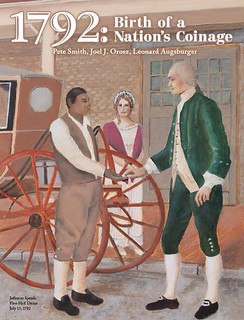 Len Augsburger writes:
Len Augsburger writes:
A copy of 1792: Birth of a Nation’s Coinage will be available for viewing at Rich Uhrich’s table (#1017) at the American Numismatic Association National Money Show in Orlando (March 9-11, 2017). Written by Pete Smith, Joel Orosz, and Len Augsburger, this book presents an in-depth examination of the United States coinage of 1792, including a comprehensive census of all known examples. Ordering details will be released by Heritage in the near future.
Orloff Printing Process Question
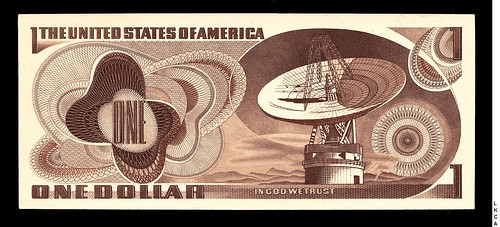
Regarding author Gene Hessler's response last week about the multi-intaglio or 'Orlof intaglio' banknote printing process, E-Sylum reader Bob Leuver of Maryland writes:
Gene's note makes it sound as if the Orloff printing method originated with De la Rue Giori. As I recall, the Orloff method of gravure/intaglio was used by Russia for banknotes. I researched the printing method with Alberto Albinati, Giori's top salesman. We discussed whether it would enhance their presses. I have forgotten just about everything I knew about the Orloff method, so my comments are not a criticism. Perhaps, Gene could enlighten me. I retired from the BEP 29 years ago, so there..
Gene Hessler writes:
Regarding the Orloff press, I know it was registered in 1897, but interpreted Prof. Hellmann's comment about this press as being a hybrid. Prof. Hellmann was in his last years when he provided this information.
By the way, my U.S. Essay Proof & Specimen Notes that was illustrated is the 2nd edition.
To read the earlier E-Sylum article, see:
PROFESSOR HELLMANN'S 1970S TEST NOTES
(www.coinbooks.org/v20/esylum_v20n09a08.html)
More on Ralph Barker
Dave Hirt writes:
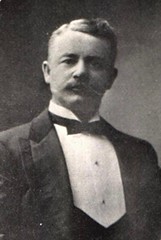 I own all the catalogs of the Barker sales. Barker consigned to three different Chapman sales, Two with the brothers, the
last with Henry. For some reason all three of these sales are scarce, and are rarely offered.
I own all the catalogs of the Barker sales. Barker consigned to three different Chapman sales, Two with the brothers, the
last with Henry. For some reason all three of these sales are scarce, and are rarely offered.
My catalog of the sale 08/13/1902 is a prize. It is Barker's personal copy. It has the lots of his consignment priced. Totals show with a 25% commission deducted. The next sale was on 07/07/1904. and the last 11/28/1913, held after Barker's death. I just obtained that one in the recent Charles Davis sale.
To read the earlier E-Sylum article, see:
RALPH RANDOLPH BARKER (1856-1913)
(www.coinbooks.org/v20/esylum_v20n09a12.html)
On Arabic Numeral Dates
Last week we published this quote from an old newspaper article about a coin from the year "787" which turned out to be a New Jersey copper from 1787.
There was found on the bank of the Ohio river, and is now in the possession of the Doctor A.D. Keith of this place, an old Roman coin, made of copper, bearing a Latin in- scription with the title of Nova Caesarae and purporting to have been coined as early as the year 787. It is something remarkable that it has not wasted more than appears; the impression of a horse's head with a plough and shield is quite plain; the letters appear to be well formed.
Martin Purdy writes:
This attribution of Arabic numerals to a period before they were in use in the West reminds me a little of an item that was on display in a private museum here in New Zealand some years ago. Supposedly a Roman coin from "A.D. 515" , its date caught my eye as being both a little too late and a little too precise. I asked for a closer look and it turned out to be a Constantinian copper of a couple of centuries earlier, with the mintmark SIS (= Siscia, now Sisak in Croatia) in the exergue! Close, but no cigar.
Martin adds:
As far as I can tell, they started in India (so not really "Arabic" at all) around the 4th century, then reached the Arab world around the 8th century, from where we picked them up around the 12th - but it took another couple of hundred years for them to get into any form of widespread use and for their shapes to become standardized, and probably another couple of hundred years again for them to start supplanting Roman numerals - quite a fascinating field for study in itself!
To read the earlier E-Sylum article, see:
1823 FIND OF OLD NEW JERSEY COPPER
(www.coinbooks.org/v20/esylum_v20n09a15.html)
Library Organization, Or Lack Thereof
Regarding the photo of my numismatic library in the last issue, Bob Leonard writes:
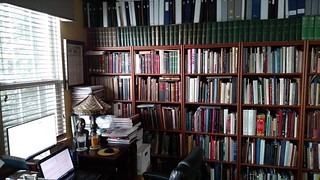 I'm reluctant to show anyone my library, because it has (1) sideways books on top of shelved books and (2) books in piles. And I have no room to add anything else!
I'm reluctant to show anyone my library, because it has (1) sideways books on top of shelved books and (2) books in piles. And I have no room to add anything else!
In a way it is reassuring to discover that I am not alone. (I trust that these books are not double shelved, i.e., that there is not a second row of books behind the visible ones. In the 1980s I visited Leroy ["Jim"] Kaczor in Champaign, a wonderful person, and I noticed that his car was parked in the driveway, though he had a garage. I was looking to buy a copy of an ANS publication and thought he might have one, since he was a long-time member of the ANS. We went out to the garage, and I found that the walls were covered with bookshelves and there were library tables in the middle. The tables were heaped with numismatic books. Checking the shelves, I found that there were books behind those in front. And he lacked the book I wanted!)
To read the earlier E-Sylum article, see:
WAYNE'S NUMISMATIC DIARY: FEBRUARY 26, 2017 : Breakfast with Jeff Garrett
(www.coinbooks.org/v20/esylum_v20n09a23.html)
Quick Quiz: Who Is This Mystery American Numismatist?
Pete Smith writes:
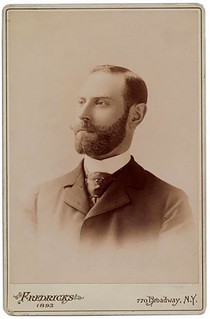 I have been working to fill gaps in American Numismatic Biographies for the listing on the Newman Numismatic Portal. One early numismatist has been known only by his first initial and last name. This made him hard to identify. His address was known from an early publication.
I have been working to fill gaps in American Numismatic Biographies for the listing on the Newman Numismatic Portal. One early numismatist has been known only by his first initial and last name. This made him hard to identify. His address was known from an early publication.
I found a city directory of a clerk with that last name living at that address. I learned that he moved to a new city and got involved selling stomach bitters. One of his bitters bottles would be a treasure to a bottle collector.
Can any E-Sylum reader identify this numismatist?
Can any E-Sylum reader identify another numismatist that crosses into the field of bottle collecting?
A Mystery Shakespeare Token
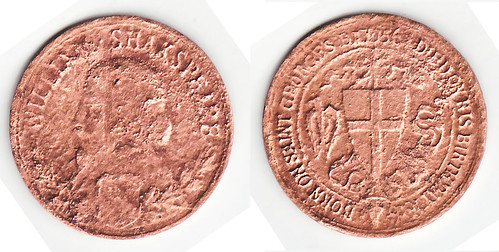
Philip De Jersey writes:
I was interested to read the piece on Shakespeare medals in the latest E-Sylum. Amongst a group of metal-detected finds bought to me last week was this copper alloy token (19mm, 1.71g), with WILLIAM SHAKSPEARE on the obverse and BORN ON SAINT GEORGE’S DAY 1564 DIED ON HIS BIRTHDAY 1616 on the reverse. There is a somewhat similar obverse on a much heavier pewter medal at https://finds.org.uk/database/artefacts/record/id/606993, issued in 1916, which provides the only parallel I have been able to find on the web.
It could be that this token is local to Guernsey, in the Channel Islands, where it was discovered, but I’ve found no mention of such an object in the standard numismatic sources for the islands, and we have no comparable items in our museum collection. Any observations or suggestions of origin would of course be welcome…
To read the earlier E-Sylum article, see:
MEDALS OF WILLIAM SHAKESPEARE
(www.coinbooks.org/v20/esylum_v20n09a24.html)
The Minting of Sixpence Coins
Last week David Pickup noted that "Sixpences were last minted in 1967 but were not withdrawn until 30 June 1980."
Gary Dunaier writes:
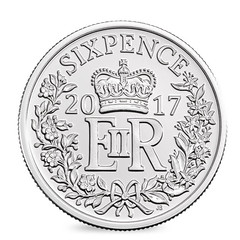 The British Royal Mint started minting sixpences again last year.
The British Royal Mint started minting sixpences again last year.
Of course, these new sixpences aren't intended for circulation but are designed for collectors, and to be given as gifts. They sell them for £30.00.
According to the Royal Mint, "The silver sixpence has long been a token of good luck, popped into Christmas puddings and the shoes of brides fulfilling the traditional rhyme ‘Something old, something new, something borrowed, something blue and a silver sixpence in her shoe’."
To read the earlier E-Sylum article, see:
NOTES FROM E-SYLUM READERS: FEBRUARY 26, 2017 : More on Withdrawn Coins
(www.coinbooks.org/v20/esylum_v20n09a07.html)
Timeless Rittenhouse
Jeff Reichenberger writes:
Has anyone mentioned the television show “Timeless”? It is a show about time travel. Briefly, there are two time machines – one is piloted by a man who wants to change historic events in an attempt to erase the recent death of his wife and daughter. The other is piloted by a team dedicated to stopping him from screwing up history. But here’s the kicker/slight numismatic nugget, they are both being manipulated by an evil entity known as ‘Rittenhouse’, and yes, this evil empire was founded by David Rittenhouse, who incidentally, is depicted as a psychopathic monster who covertly controls the country. They never mention his pulling the strings at the U.S. Mint, and he is shot to death in episode 10, but his maniacal followers are still ‘controlling’ us presently! Hmm, isn’t there a group of numismatists who call themselves “The Rittenhouse Society”? Just what are you folks up to??
I find the program somewhat entertaining, though redundant.
Sorry, Jeff. I'm afraid now we'll have to have you killed. Actually, one of the Rittenhouse Society members mentioned this show the other day; I haven't seen it. Time travel is always a great excuse for a plot. Who wouldn't love the opportunity to travel though time to save the world, even the score with an old bully, kiss that girl, or just get rich?
Founded in 1957 and named for scientist and first Director of the U.S. Mint David Rittenhouse, the Rittenhouse Society is a small group that meets once a year for breakfast at the annual American Numismatic Association summer convention. We're all numismatic researchers and writers, and with all our projects no one has time to control the world. We may have a few geniuses, but no one's evil. -Editor
Authenticating Odd & Curious Money
Regarding the Katanga cross, last week I wrote:
I've always been oddly curious about odd & curious money. Can these crude items ever be truly authenticated as having been used as money?
Bob Leonard writes:
Check your copy of Curious Currency, or Quiggin, who I quoted.
Curious Currency, p. 82, footnote 37, citing Quiggin, A Survey of Primitive Money, pp. 77-79. A couple of citations from Quiggin: "Cameron, crossing over lake Tanganyika ...in 1874, found that his trade-beads...were of no further value and he had to use the Urua crosses, here called handa. These were larger than the average type, 15 to 16 inches..." (Quiggin, p. 78, citing Cameron, 1877, I, p. 319). Quiggin mentions some prices in terms of Katanga crosses: a gun, 10, and 4 fowls or a fathom of cloth, 5. In 1924 bride-price was 14 large crosses, a large she-goat, a piece of indigo drill (a kind of cloth), and a female slave (yes, slavery had not yet been abolished in Africa then). On p. 79 is the divorce anecdote I quoted, though I switched the order of items returned for better effect.
To read the earlier E-Sylum articles, see:
NUMISMATIC NUGGETS: FEBRUARY 26, 2017 : Katanga Cross
(www.coinbooks.org/v20/esylum_v20n09a19.html)
MORE ON NOODLE MONEY IN AMERICAN PRISONS
(www.coinbooks.org/v20/esylum_v20n09a20.html)
Shaving In the Old Treasury Vault
Regarding the antics of the guy in the back of the photo of the Old U.S. Treasury Vault we've been discussing,
Ron Haller-Williams writes:
I reckon he's most likely shaving - note the white patch on his face, and the fact that the guy at rear top right is holding a mirror in the right position for him! See attached detail, with brightness/contrast slightly tweaked.
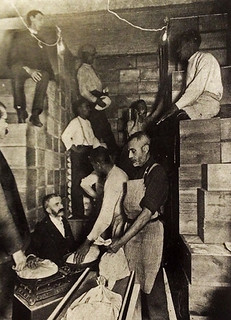
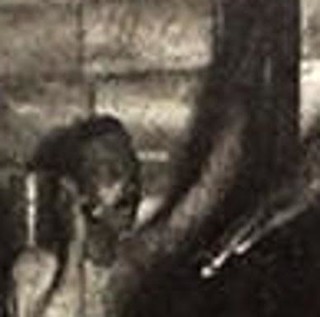
To read the earlier E-Sylum articles, see:
THE OLD U.S. TREASURY VAULT
(www.coinbooks.org/v20/esylum_v20n08a22.html)
NOTES FROM E-SYLUM READERS: FEBRUARY 26, 2017 : Ordering Lunch at the Old Treasury Vault
(www.coinbooks.org/v20/esylum_v20n09a07.html)

THE 1917-1919 SUSPENSION OF U.S. GOLD COINS
Regarding my question about the "plan to take the gold piece out of circulation" mentioned in the 1917 newspaper article quoted last week, Kent Whiting writes:
According to David Lange in his NGC column on the Coins of 1916 part 3, Congress changed the gold coin reserve requirement for backing gold certificates from 2/3 to 1/3 the amount of notes outstanding. The 1/3 reserve could be met by existing gold coins in Treasury vaults. With the exception of the western states, gold did not circulate at the time and was only used for gold certificate reserves. Therefore it was determined that no new mintage of gold coins was required. So far I have been unable to find reference to this decision in the mint reports or annual reports of the Secretary of the Treasury. Mintage of gold coins did not resume until 1920. I assume this is the “plan” they were referring to?
To read the complete article, see:
USA Coin Album: The Coins of 1916 - Part 3
(www.ngccoin.com/news/article/4186/USA-Coin-Album-The-Coins-of-1916-Part-Three/)
Regarding your question about the withdrawal of gold coins in 1917, this was well known to me from my reading of various sources. My interest in the subject was prompted by the glaring suspension of United States gold coin production during 1917-19, years in which the only gold coin struck was the non-circulating 1917 McKinley Memorial Gold Dollar.
The onset of World War I in 1914 quickly led to fluctuations in precious metals prices, hoarding and inflation. As a result, nearly all countries then on the gold standard suspended it until further notice, this going into effect by the end of 1915. The USA was somewhat insulated from the war's effects, but it finally succumbed to economic pressure by suspending the production and circulation of gold coins for the war's duration, while still retaining the gold standard until 1933. This policy went into effect in March of 1917, as was anticipated in the newspaper article you reproduced. Also largely removed from circulation were gold certificate notes, these being replaced with Federal Reserve Notes.
I found a good account in the book A Monetary History of the United States 1867-1960, by Milton Friedberg and Anna Jacobson Schwartz. It includes a quote from another reference that largely explains the situation:
"The withdrawal of over $1 billion of gold coin and certificates from circulation was effected as part of the policy of concentrating gold in the Federal Reserve System and was achieved by asking the banks to cooperate by 'sorting out of your incoming cash the gold certificates, not paying out any such certificates over your counter unless especially requested, but instead, forwarding to this bank [New York Federal Reserve] all you may accumulate in excess of those you think it advisable to carry as part of your vault money.' The banks were asked to pay out Federal Reserve notes, instead, and the public was discouraged from requesting gold coins for gifts."
Giving out gold coins at holidays and birthdays was a longstanding tradition, gold dollars being used in the period when they were current, and quarter eagles being used in later years. I have several examples of small envelopes from the 1890s - 1920s that were specifically designed to hold a quarter eagle and printed with text indicating that it was a gift.
Given the circumstances of gold coin withdrawal, westerners had no choice but to accept paper currency in its place. Under the Pittman Act of 1918, silver certificates were likewise withdrawn and replaced with Federal Reserve Notes, millions of silver dollars then being freed up for melting. With the price of silver rising rapidly during the war, finally exceeding the melt value of silver dollars by 1920, these coins temporarily became scarce in the West, too. The price of silver fell toward the end of 1920, the melted silver dollars were replaced starting the following year, and that crisis passed. The minting of gold coins resumed in a limited manner in 1920, but most of these were never released to domestic circulation. Large numbers went overseas, only to be repatriated after World War II for the benefit of collectors, but millions were never issued and succumbed to mass melting in 1936-37. This accounts for the many rare dates among high mintage issues of the 1920-33 years.
To read the earlier E-Sylum article, see:
THE END OF CIRCULATING GOLD IN THE WEST
(www.coinbooks.org/v20/esylum_v20n09a16.html)
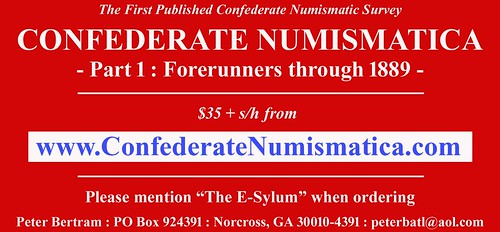
OLGA KORBUT'S OLYMPIC MEDALS SOLD
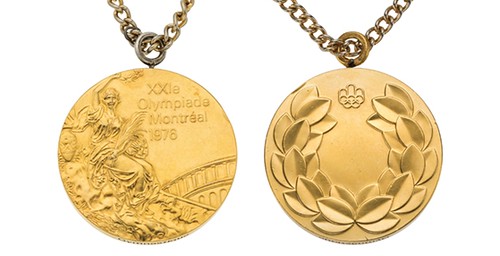
While the Russian media reported that Olympic gold medalist Olga Korbut sold several of her medals at auction after running into money troubles, Korbut shot down the reports Tuesday and said she's not in "financial crisis."
Three Olympic gold and two silver medals won by the Russian gymnast in Munich in 1972 and Montreal four years later were sold by Heritage Auctions, an international auction house with its headquarters in Dallas.
Elon Werner, director of communications at Heritage Auctions, said 32 lots of Korbut's memorabilia were sold for $333,504.
Some of Korbut's items that sold at auction:
- 1972 Olympic gold medal from the women's team competition — $66,000
- 1976 Olympic gold medal from the women's team competition — $57,600
- Leotard worn in USSR Gymnastics Display — $3,000
A Russian news outlet, gazeta.ru, reported that selling the medals saved Korbut from hunger. But Werner said, "it wasn't a financial decision on her part," adding that Korbut is living comfortably in Scottsdale, Ariz., with her fiance.
Korbut had taken her medals to appearances through the years, sharing them with fans. Her decision to sell the medals was made in the spirit of the Olympics, Werner said.
"She wanted to actually control how those medals went out into the world," he said.
In a statement released by Heritage Auctions, Korbut said she was pleased with the results of the auction.
In 1972, Korbut won three gold medals at the Munich Olympics at age 17. She won the individual balance beam and floor exercise and also took gold in the team competition. She was the silver medalist on the uneven bars.
Four years later, she took home two more medals from Montreal, gold in the team competition and silver on balance beam.
“This is Olympic history, and I would like to share with the whole world,” Korbut, 61, was quoted as saying in the AP story. “They helped to make it history and make it live forever. This is how I wanted to share with the people.”
To read the complete article, see:
Former Olympic gymnast sells gold medals at auction
(www.usatoday.com/story/sports/olympics/2017/02/28/olympic-gymnast-sells-medals-after-financial-troubles/98522684/)
To read the earlier E-Sylum article, see:
HERITAGE OFFERS OLGA KORBUT'S OLYMPIC MEDALS
(www.coinbooks.org/v20/esylum_v20n07a25.html)
VOCABULARY TERM: LUNETTE
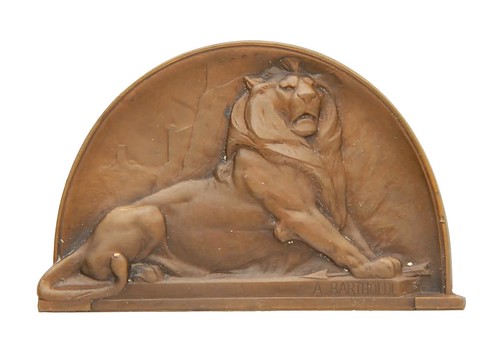
Medals possess the feature that they can be any shape. This Encyclopedia lists 67 of these shapes plus eleven with a possible number of sides (coins can appear in multisided shape, medals in more exotic shapes). Often the shape is significant to the theme of the medal.
Lunette.
Half round or crescent shaped; a medal in half round shape, or a semi-circular panel within a design. The term comes from architecture where a lunette is a semi-circular opening where decorative work is located. It is also found on 18th century furniture with a fan-shaped decoration. See unusual shape.
CLASS 02.13
References:
A32 {1975} Osborne.
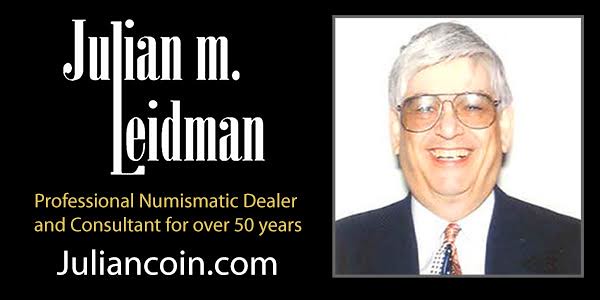
CHARLES FREDERICK GüNTHER (1837–1920)
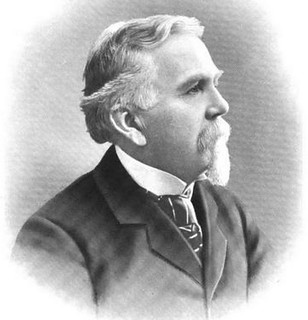 Carl Friedrich "Charles Frederick" Günther (1837–1920), "The Candy Man," "Cracker-Jack King" and "The P. T. Barnum of Chicago" was a German-American politician, caramel confectioner, chocolatier, numismatist, and art, antiquities and curiosities collector, who, purchased many of the coins and artifacts now in the Chicago History Museum.
Carl Friedrich "Charles Frederick" Günther (1837–1920), "The Candy Man," "Cracker-Jack King" and "The P. T. Barnum of Chicago" was a German-American politician, caramel confectioner, chocolatier, numismatist, and art, antiquities and curiosities collector, who, purchased many of the coins and artifacts now in the Chicago History Museum.
He was born on March 6, 1837, in Wildberg, in the Schwarzwald or "Black Forest" district of Baden-Württemberg, Germany, son of Johann Martin Günther, a candle and soap maker, and his wife Marie. In 1842, when he was five years old his family moved to America and at first settled in Columbia, Lancaster County, and in 1848 moved on at Somerset County, Pennsylvania.
His parents raised him speaking both English and their native German and French. Later on Gunther also learned Spanish. While at Pennsylvania he attended private elementary schools. As a young boy of ten he worked as a letter-carrier on horseback for the United States Post Office for twenty-five cents per diem. When he became a teenager, in 1850, his family removed to the Illinois Valley in what is today known as Peru, La Salle County, Illinois.
By 1860, he became involved through his family and business connections with the ice industry since Peru at that time was a large ice harvesting and shipping center, collecting ice from the canal connecting Chicago with the Mississippi watershed.
Gunther moved to Memphis, Tennessee, in December 1860, and worked for an ice importer and distributor, Bohlen, Wilson & Company, who imported ice from Peru, Illinois. Five months later the Civil War broke out and the ice business suffered. He aided the Confederate Army as a civilian in military service working as a steward and purser buying supplies and ferrying troops along the Mississippi River. His own account is preserved in his diaries during the two years he worked sailing and ferrying Confederate soldiers on the steamboat Rose Douglass along the Mississippi River, now available through the research and publication by Bruce S. Allardice and Wayne L. Wolf, Two Years Before The Paddlewheel : Charles F. Gunther Mississippi River Confederate. (Texas A & M, 2012).
In December 1862, his ship was captured and destroyed at Van Buren, Arkansas. Gunther was captured by Union forces on the Arkansas River and held prisoner by the U. S. Army at Arkansas, but released to return home to Illinois. After his return to Illinois he became employed at the Peoria Bank. He worked there only a short term and became employed by C. W. Sanford as a candy salesman selling and distributing confections in the southern states. He made his first trip to Europe and returning to America worked for Thompson, Johnson & Company, Grocers. After a two year stay with the wholesale grocers firm he joined Greenfield, Young & Company of New York as their Chicago representative as a distributor of their confections at Chicago.
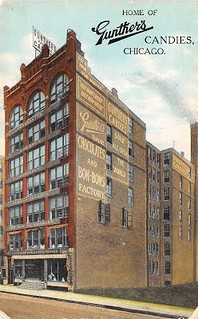 In 1868, he opened a candy store at 125 North Clark Street, Chicago, Illinois. Although caramel candy was known in England and Europe since the beginning of the eighteenth century, it is said that Gunther introduced their production into America through his Chicago candy factory. His corporate motto "Not so cheap, but how good." On May 2, 1870, he married Jennie Burnell (1849-1928), of Lima, Illinois, and they had two sons. The Great Fire from October 8th to 10th, 1871, destroyed his store, inventory, and early formed collection of rare artifacts that included a copy of the Emancipation Proclamation. He first opened a soda parlor in the McVicker's Theater building. Afterwards he was able to reestablish himself in 1872 at 212 State Street, Chicago, and his business began to take off and boomed by 1875. Among his confectionery treats were chocolate candy cigars he called La Flor de Gunther Cigars' de chocolate.
In 1868, he opened a candy store at 125 North Clark Street, Chicago, Illinois. Although caramel candy was known in England and Europe since the beginning of the eighteenth century, it is said that Gunther introduced their production into America through his Chicago candy factory. His corporate motto "Not so cheap, but how good." On May 2, 1870, he married Jennie Burnell (1849-1928), of Lima, Illinois, and they had two sons. The Great Fire from October 8th to 10th, 1871, destroyed his store, inventory, and early formed collection of rare artifacts that included a copy of the Emancipation Proclamation. He first opened a soda parlor in the McVicker's Theater building. Afterwards he was able to reestablish himself in 1872 at 212 State Street, Chicago, and his business began to take off and boomed by 1875. Among his confectionery treats were chocolate candy cigars he called La Flor de Gunther Cigars' de chocolate.
At that time he began decorating his candy store with antiques and artifacts, coins and curiosities. In 1877, he purchased the deathbed of Abraham Lincoln setting it up in his store. He was also extremely naive and was easily bilked by flimflam artists who sold him fake relics and antiquities like the West Point Chain, the "Skin of the Serpent that Tempted Eve in the Garden of Eden", and the mummified remains of Moses' foster mother Bithiah. Yikes!
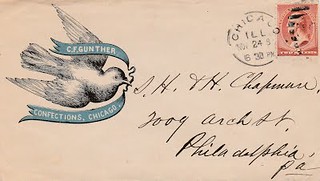 In the January 1934 issue of The Numismatist on page 58, Mr. Davis of the Chicago Coin Club exhibited at the 177th meeting on November 1, 1933, a Confederate $10 note with the advertisement of C. F. Gunther of Chicago. Unfortunately, this is not listed in Bob Vlack's An Illustrated Catalogue of Early North American Advertising Notes. In the January 1968 issue of The Numismatist, on page 39, Melvin Fuld published on the Charles F. Gunther token. The obverse with the CENTENNIAL EXPOSITION OF CHICAGO 1876. Reverse with Spread Eagle and with the legend EAT GUNTHER"S CANDY AND YOU BE HAPPY. See Rulau IL-Ch 11, an 1876 white metal 30 mm token.
In the January 1934 issue of The Numismatist on page 58, Mr. Davis of the Chicago Coin Club exhibited at the 177th meeting on November 1, 1933, a Confederate $10 note with the advertisement of C. F. Gunther of Chicago. Unfortunately, this is not listed in Bob Vlack's An Illustrated Catalogue of Early North American Advertising Notes. In the January 1968 issue of The Numismatist, on page 39, Melvin Fuld published on the Charles F. Gunther token. The obverse with the CENTENNIAL EXPOSITION OF CHICAGO 1876. Reverse with Spread Eagle and with the legend EAT GUNTHER"S CANDY AND YOU BE HAPPY. See Rulau IL-Ch 11, an 1876 white metal 30 mm token.
From 1888- September 21, 1889, he reconstructed the Libby Prison War Museum, originally built in Richmond, Virginia, shipped stone by stone and purveyed by train via 132 twenty-ton cars to Chicago, was rebuilt on South Wabash Avenue, Garfield Park, which housed the largest collection of war relics known in the country. The Museum had a gift shop which Gunther called "Uncle Tom's Cabin" in which he sold silver Lincoln souvenir spoons, Libby Prison War Museum cigars, and other memorabilia including a 6"x6" guidebook, A Trip Through The Libby War Museum Chicago.
The building originally was erected in 1845 by Luther Libby and occupied by him and his company Luther Libby & Sons, Shipchandlers. In 1861 it was taken over by the C.S.A. and converted into a war prison. After 1899 it was torn down and became the site of the Chicago Coliseum, which Gunther organized and was its first president. This and the 1893 Libby Prison Medal were written about in detail in the June 1945 issue of The Numismatist on page 572-574.
Gunther also assembled one of the largest collections of Washingtoniana and Lincolniana.
In September 1892 when various proposed designs were being published and discussed for the Columbian Exposition Commemorative Half Dollar Gunther objected to the first one asserting his portrait of Columbus was a true likeness, not that offered by the director of the Philadelphia Mint. That year he donated three photographs of the Moro portrait of Columbus to the Detroit Museum of Art. This was recently discussed by Nancy Oliver and Richard Kelly, "Columbus Controversy," The Numismatist, November (2013) : 98-99.
In the July 1894 issue of The Numismatist on page 152, it was speculated that the Gunther Collection together with that of the H. H. Gatty and Gunning Collections of idols might go to the Field Museum.
In 1893, he introduced a new product line called "Cracker-Jacks," which became an immediate sensation lasting up to our day!
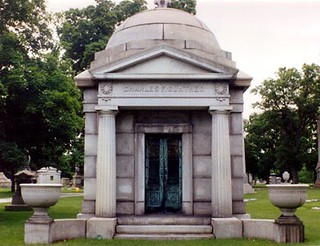 He died of pneumonia on February 10, 1920, at the age of 83, at his home 3601 South Michigan Avenue, Chicago, Illinois. His funeral was at his home. He was a member of the Episcopal Church. He was survived by his wife and son Burnell (1871-1926). He was buried in the family mausoleum at Rose Hill Cemetery, Chicago, Cook County, Illinois, where his son Whitman (1872-1907) had been interred thirteen years earlier. His death was announced by Theo Leon at the twelfth meeting of the Chicago Coin Club at the Sherman Hotel, Chicago, on Wednesday, March 3, 1920, and was published in the May 1920 issue of The Numismatist, page 208.
He died of pneumonia on February 10, 1920, at the age of 83, at his home 3601 South Michigan Avenue, Chicago, Illinois. His funeral was at his home. He was a member of the Episcopal Church. He was survived by his wife and son Burnell (1871-1926). He was buried in the family mausoleum at Rose Hill Cemetery, Chicago, Cook County, Illinois, where his son Whitman (1872-1907) had been interred thirteen years earlier. His death was announced by Theo Leon at the twelfth meeting of the Chicago Coin Club at the Sherman Hotel, Chicago, on Wednesday, March 3, 1920, and was published in the May 1920 issue of The Numismatist, page 208.
The Chicago Historical Society purchased Gunther's vast collection soon after his death paying less, $21,321.20, far less than the originally agreed on price from the estate for $150,000. On Thursday, August 26, 1920, at 2 P. M., the ANA Convention held at Chicago, held tours of the Gunther Collection at the Chicago Historical Society as part of the Convention program. A very quick and non descriptive mention of that visit was published in the October 1920 issue of The Numismatist on page 462.
To read the complete article, see:
GUNTHER, CHARLES FREDERICK
(https://sites.google.com/a/numismaticmall.com/www/numismaticmall-com/gunther-charles-frederick)
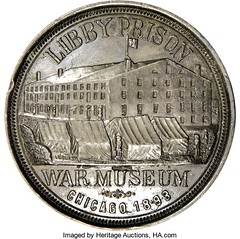
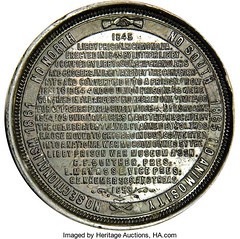
Columbian World's Fair Libby Prison Exhibit Medal. White metal, copper-plated, 68 mm, 181.8 gm. Eglit-477. Obverse Libby Prison War Museum Chicago 1893 with view of prison. Reverse has a long inscription about the Southern prison for Union troops during the Civil War. Charles F. Gunther and others had the prison dismantled and rebuilt on the ground of the Columbian World's Fair. (NGC ID# CGJF, PCGS# 661060)
To read the complete lot description, see: Libby Prison War Museum Chicago 1893 Medal (https://coins.ha.com/itm/expositions-and-fairs/columbian-world-s-fair-libby-prison-exhibit-medal/a/427-81526.s)

1948 VIEW OF CALIFORNIA FRACTIONAL GOLD
I just want to point out another opposite point of view, one very much consistent with my own, about the souvenir fractional gold published in 1948. George G. Reusch of Medford, Wisconsin wrote a query put to Mr. Cottin, Jr., of The Numismatic Scrapbook, published in the December issue on page 1168, which reads :
"How can I tell the real California gold pieces from the so-called souvenir or tokens?"
Here was the answer :
"The pieces generally considered to be genuine have the value expressed as "Dollar," or "D," while pieces definitely known to be souvenirs or "charms" have simply "1/4," "1/2" or "1." It is not entirely without justification that some collectors consider many of the so-called genuine small California pieces to be souvenirs too. The only book on the subject is by Ed. M. Lee's "California Gold Quarters, Halves and Dollars." It is a descriptive list and makes no attempt to explore the background of the pieces other than to state, "So far as can be ascertained, the names of the persons or firms responsible for issuing the smaller coins are unknown. But from designs and quality it is thought that many of them were struck by the same parties issuing the larger denominations, while others were coined by responsible jewelers and merchants."
In 1871, Federal authorities apprehended a party in Leavenworth, Kansas who was striking gold half dollars described as follows : obverse, female head with thirteen stars and date 1871; reverse, wreath enclosed the words "Half Dollar' Cal." (Lee numbers 54 to 57 have a similar description.) The Director of the Mint's report for 1871 states that a large quantity of these pieces were struck.
About 1880 the government prohibited the placing of a denomination on the pieces, hence the 1/4, 1/2 and 1 being used on known "charms."
From 1900 to 1920 large quantities of these "charms" were sold, mainly to tourists, visiting the Far West.-- and they were manufactured, in other places, in Seattle and Chicago.
If they were not all destroyed in the Great Earthquake, old San Francisco newspaper files should shed some light on the subject as to whether the small gold pieces actually circulated as money and if so when the circulation ceased. The subject offers a challenge to the numismatist of inquiring turn of mind."
To read the earlier E-Sylum articles, see:
THE JOSEPH BROTHERS
(www.coinbooks.org/v20/esylum_v20n02a16.html)
MORE ON THE JOSEPHS AND NUMISMATIC RESEARCH
(www.coinbooks.org/v20/esylum_v20n04a11.html)
NOTES FROM E-SYLUM READERS: FEBRUARY 19, 2017 : California Fractional Gold After 1870
(www.coinbooks.org/v20/esylum_v20n08a12.html)
BOSTON CLUBS SPONSOR 2017 ROCKWELL LECTURE
Jointly sponsored by: Boston Numismatic Society,
Collectors Club of Boston & Currency Club of New England
Tuesday April 11, 2017 at 7:15 pm.....Trinity Congregational (Korean) Church
730 Main St. (Rt 20) Waltham, Mass.
This year we are happy to announce that John Frost will be our speaker. John is an expert on Liberty Seated and Barber coinage along with odd-ball denominations especially 20c pieces. He is a co-author of: Double Dimes-The United States Twenty Cent Piece, now the standard reference on the series. Currently, John is Director of Education of the Liberty Seated Collectors Club, President and Journal Editor of the Barber Coin Collectors Society and co-president of the Worcester County Numismatic Society. He is also a contributor to Red Book and instructor at the ANA Summer Seminar.
Three Numismatic Vignettes.
A Discussion of:
--Oddball denominations—the least studied and collected denominations.
--The Power of Knowledge—how specialized expertise can lead to fascinating discoveries, and profits.
--Discovery, another discovery & an exhibit—the excavation of discarded coin dies, a previously unknown 20-cent piece marriage & the tale of discovery leading to an exhibit at the Nevada State Museum, the former Carson City Mint.
You are invited to join us this night. Light refreshments will be available. For
further information: C. John Ferreri, johnnybanknote@yahoo.com
860-429-6970.
QUERY: WHO MADE THIS MARYLAND MYSTERY PLAQUE?
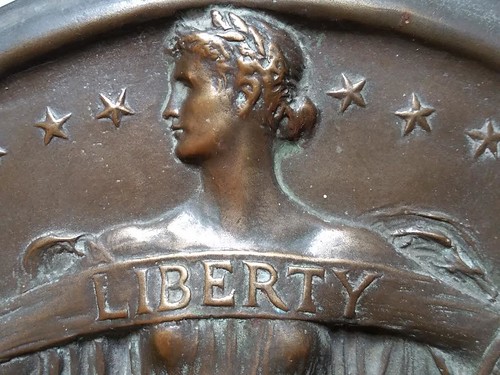
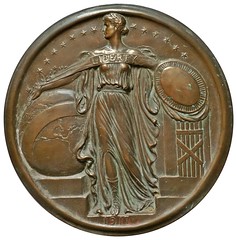
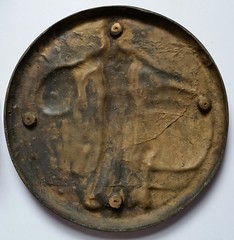
Alan Stullenbarger of CoinZip.com writes:
The plaque was removed from the Liberty Trust Company of Maryland building in Cumberland MD. The building is still in use today, not as a bank. It weighs about 8 pounds and measures about 12 inches in diameter and is about 1/2 an inch thick on the rim. The 4 holes on the back were used to fasten the plaque to the building. I believe this was their logo as I have seen the design on other items from the bank.
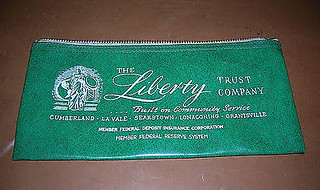
Rich Jewell writes:
I have a couple of guesses, but I'm not certain.(A.A. Weinman or Hans Schuler)
Dick Johnson writes:
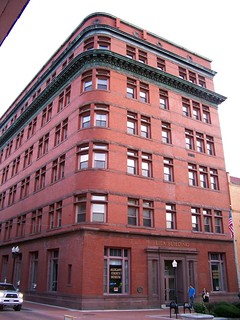 There is strong possibility this bronze cast is a rejected design for the U.S. quarter dollar. Without a monogram or initials it is impossible to accurately identify the artist. My only suggestion is to search U,S, Mint records for that period with the hope there exists some reference to identify it. These records are in the National Archives in Philadelphia, Record Group 104.
There is strong possibility this bronze cast is a rejected design for the U.S. quarter dollar. Without a monogram or initials it is impossible to accurately identify the artist. My only suggestion is to search U,S, Mint records for that period with the hope there exists some reference to identify it. These records are in the National Archives in Philadelphia, Record Group 104.
Rejected designs were returned to the artist and were seldom destroyed, but come on the market usually when the artist estate was dispersed. It would not be unusual for such art work to end up on a bank wall.
MORE ON THE BUTLER COLORED TROOPS MEDAL
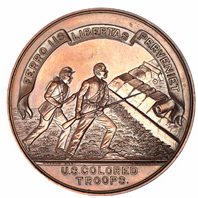
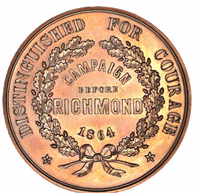
During 1862 consideration was given in Washington to freeing the slaves but the first step was to authorize black army regiments. The first such units were created in early 1863 and by war’s end 179,000 black soldiers had been enrolled, of which 37,000 died.
Most black regiments served in the East, especially in Virginia under Gen.Ulysses S. Grant. The struggle between Grant and Gen. Robert E. Lee was especially fierce in the fall of 1864 with the Union army slowly moving towards the Confederate capital at Richmond.
In September 1864, as Grant came closer to Richmond, two key forts barred his way. The resulting Battle of New Market Heights was but one phase of the struggle and involved the use of black troops in a critical manner.
The Union general over the black troops was Benjamin Butler, one of the more colorful commanders. When New Orleans was captured by Adm. Farragut in 1862, Butler was appointed military governor. He ruled with an iron fist, even hanging a local gambler who tore down a U.S. flag. He soon acquired the unenviable nickname of “Beast” Butler.
While military governor in Louisiana, Butler underwent a change in his view of blacks. At first he considered escaped slaves to be contraband, useful only as workers. Within a few months he saw the value of using blacks as a civil guard, thus freeing up regular troops. Butler then formally suggested raising black regiments for military operations but was told not to interfere in policy decisions. In 1864, however, Butler joined Grant’s command.
Butler was so impressed with the black troops at Gilmer and Harrison that he did something no other Union general had done: he decided to have a special medal struck in their honor. To this end he wrote Mint Director James Pollock.
At Pollock’s suggestion, Butler contacted Anthony Paquet, a former Mint engraver who had resigned to do private commissions. Paquet prepared the dies and the work was approved by Gen.Butler.
In the spring of 1865 the Philadelphia Mint struck 197 silver and 11 copper medals and they were then sent to the Bigelow & Kennard firm in Boston. That company attached a ribbon and hanger to the silver medals; the copper pieces were meant for distribution by Butler but the silver medals, with a few exceptions, had the recipient’s name engraved on the edge.
Whenever possible Butler awarded the medals in person to the living recipient or the family in case of the soldier’s death.
The obverse shows two black soldiers charging a fort with a Latin legend “FERRO IIS LIBERTAS PERVENIET” (“Freedom will come to them by the sword”) while below is “U.S. Colored Troops.” The reverse has a simple inscription “DISTINGUISHED FOR COURAGE, CAMPAIGN BEFORE RICHMOND 1864” within a wreath.
In his memoirs Butler had this to say:
“I had the fullest reports made to me of the acts of individual bravery of colored men on that occasion, and I had done for the negro soldiers…what the government has never done for its white soldiers – I had a medal struck of like size, weight, quality, fabrication, and intrinsic value with those which Queen Victoria gave to her distinguished private soldiers of the Crimea…Since the war I have been fully rewarded by seeing the beaming eye of many a colored comrade as he drew his medal from the innermost recesses of its concealment to show me.”
These medals are rarely seen today and named silver pieces are of the greatest rarity. They are in strong demand from serious collectors.
To read the complete article, see:
Butler’s medal honored efforts of black troops
(www.numismaticnews.net/article/butlers-medal-honored-efforts-black-troops)
To read the earier E-Sylum article, see:
BLACK HISTORY IN NUMISMATICS
(www.coinbooks.org/v20/esylum_v20n07a13.html)

NUMISMATIC NUGGETS: MARCH 5, 2017
Germanicus Bronze

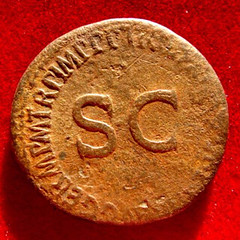
Roman Empire - Germanicus, father of Caligula (died AD 19) bronze as (10,50 g. 28 mm.). Rome mint, 42 A.D. Claudius I restitutio. Large S.C. Scarce.
GERMANICVS CAESAR TI AVG F DIVI AVG N. Bare head of Germanicus, right.
TI CLAVDIVS CAESAR AVG GERM P M TR P IMP P P. around large S C. RIC (Claudius) 106
Good fine condition. Nice old cabinet red-brown patina. Almost complete legends, nice portrait and great example from this scarce Claudius I restitutio of Germanicus bronze as!! 10,50 g. 28 mm.
To read the complete lot description, see:
36. Roman Empire - Germanicus, father of Caligula (died AD 19) bronze as (10,50 g. 28 mm.). Rome mint, 42 A.D. Claudius I restitutio. Large S.C.
(https://auction.catawiki.com/kavels/10536521-roman-empire-germanicus-father-of-caligula-died-ad-19-bronze-as-10-50-g-28-mm-rome-mint-42-a-d-claudius-i-restitutio-large-s-c)
Savilla Spain Silver Real
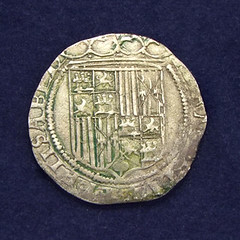
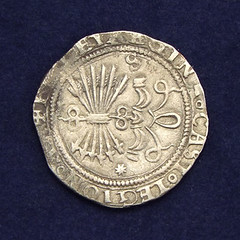
1 silver Real, struck in Sevilla under the Catholic Monarchs Ferdinand II of Aragon & Isabella (1469-1504).
Obverse: Crowned shield of Castile-Leon and Aragon.
Reverse: Yoke with traces and sheaf of arrows, S (mint mark Sevilla). Diameter: 24,5 mm Weight: 3,37 grams.
To read the complete lot description, see:
35. Spain, Sevilla - Catholic Monarchs - 1 Real - Silver - Sevilla mint
(https://auction.catawiki.com/kavels/10467887-spain-sevilla-catholic-monarchs-1-real-silver-sevilla-mint)
1832 City of London Reform Bill Medal
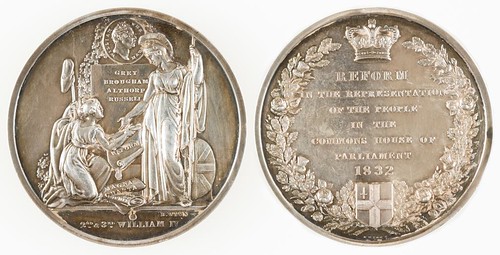
CITY OF LONDON MEDAL. REFORM BILL, 1832. Struck in AR, by B. Wyon. Obv: "REFORM IN THE PRESENTATION OF THE PEOPLE
To read the complete lot description, see:
CITY OF LONDON MEDAL. REFORM BILL, 1832.
(www.dukes-auctions.com/auctions/86/lot/500/
CITY+OF+LONDON+MEDAL.+REFORM+BILL%2C+1832.+)
For more information on the 1832 Reform Act see:
The 1832 Reform Act
(www.bl.uk/learning/histcitizen/21cc/struggle/chartists1/
historicalsources/source2/reformact.html)
1833 Kingdom of Sardinia 50 Cent
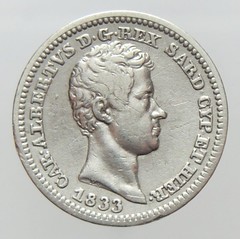
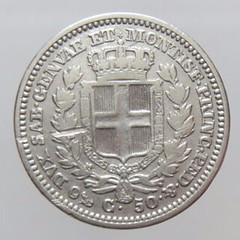
Kingdom of Sardinia - 50 Cent, 1833, Genoa, Carlo Alberto – silver
Note: Very rare coin (R3) Only 136 specimens produced!
References: Gigante Catalogue n°: 140
To read the complete lot description, see:
48. Kingdom of Sardinia - 50 Cent, 1833, Genoa, Carlo Alberto – silver
(https://auction.catawiki.com/kavels/10532067-kingdom-of-sardinia-50-cent-1833-genoa-carlo-alberto-silver)
1857 Prince Edward Island "Self Government" Token
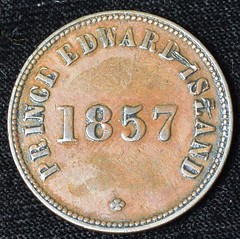
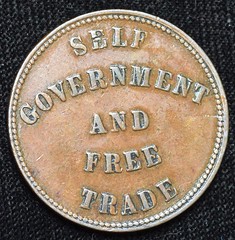
Description: Token issued by prince Edward Island "self Government and Free Trade" 1857
To read the complete lot description, see:
Lot 126: 1857 Prince Edward Island "Self Government" token
(www.invaluable.com/auction-lot/-1-c-0DF402C85C)
1866 Hong Kong Dollar
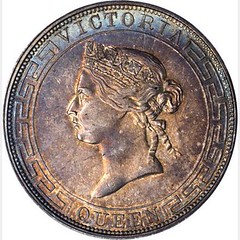
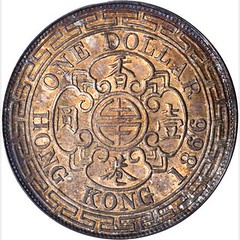
HONG KONG. Dollar, 1866. PCGS AU-55.
KM-10; Mars-C41. Beautiful colorful toning pervading the entire surface. Golden and magenta coloring is found in the centers while the most vibrant lilac, royal blue and seafoam green highlights are found in the outer periphery. Only mild bag marks and light touches of wear to high points consistent with the assigned grade
To read the complete lot description, see:
71001 HONG KONG. Dollar, 1866.
(https://auctions.stacksbowers.com/lots/view/3-6WVQC)
1934 V8 Ford Century Of Progress Medal
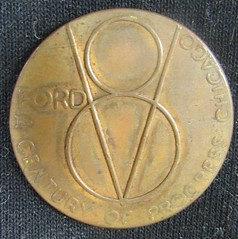
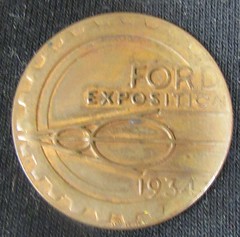
Description: 1934 V8 Ford Century Of Progress Exposition, Chicago Worlds Fair Token, 1 1/4"
To read the complete lot description, see:
Lot 190: 1934 V8 Ford Century Of Progress Exposition, Chicago Worlds Fair Token, 1 1/4"
(www.invaluable.com/auction-lot/-1-c-5B043F78B4)
Butcher's Slaughter Token
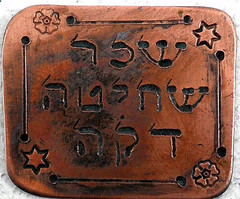

Description: Copper token, 'thin slaughter wages' A copper token, 'thin slaughter wages', Dimensions: 3.5X4 cm.
HEBREW
טוקן נחושת 'שכר שחיטה דקה'
טוקן נחושת 'שכר שחיטה דקה', מידות: 3.5X4 ס"מ.
Bill writes:
Tokens like this were used to pay the butcher or the Rabbi who would "slaughter" chickens the "Kosher" way. They were used in Europe quite frequently in the 18th and 19th century. I'm not familiar with the one pictured and to me it looks quite modern.
To read the complete lot description, see:
Lot 121: Copper token, 'thin slaughter wages'
(www.invaluable.com/auction-lot/-1-c-7484BC5881)
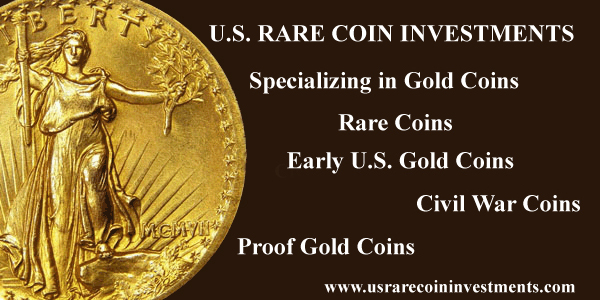
SELECTIONS FROM STACK'S BOWERS MARCH 2017 SALE
Lot 55: 1800 Washington Hero of Freedom Medal
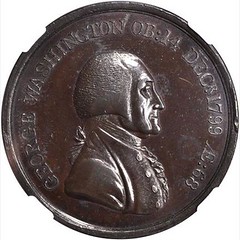
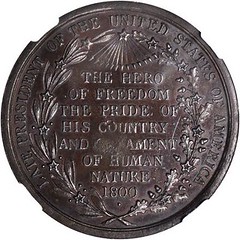
1800 Washington Hero of Freedom Medal. Struck over a 1797 Great Britain Twopence. Bronze. 38 mm. By Obadiah Westwood. Baker-79BA, Musante GW-81. Plain Edge. MS-63BN (NGC).
Struck on a Great Britain cartwheel twopence of 1797, a hardened and unusually thick host with high rims that may have presented some challenges in getting the higher central areas of relief to fully strike up on this medal. The softness seen here was also observed on the LaRiviere specimen, though to a lesser degree. Traces of the undertype are very few, but portions of incuse letters TANN of BRITANNIA may be seen on the reverse rim near 4 o'clock. Though some finishing process was undertaken on the edge, there is one small area with diagonal reeding still visible.
To read the complete lot description, see:
1800 Washington Hero of Freedom Medal. Struck over a 1797 Great Britain Twopence. Bronze.
(https://auctions.stacksbowers.com/lots/view/3-6Y1PR)
Lot 59: 1803 Wisdom Virtue & Patriotism Washington Fame Medal
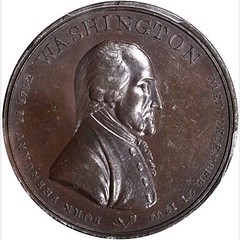
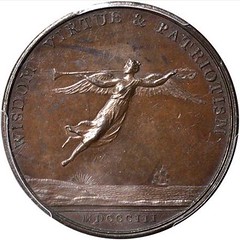
The Fame medal is considered by many to be the finest of the Washington memorial medals and it has long been prized by serious collectors of Washingtoniana, a field of numismatics that enjoyed strong enthusiasm at the same time that American numismatic pursuits became more widespread and popular in the years leading up to the Civil War. In fact, an example of this medal appeared in W. Elliot Woodward's sale of the John F. McCoy Collection in May 1864, and sold for $85 to J.N.T. Levick, a substantial sum at a time when the price record for any United States coin was less than $500.
While this medal falls under the aegis of American historical medals in terms of its audience, as with other early Washington pieces, this was produced in England, most likely by John Gregory Hancock, his mark "H" on Washington's truncation. While Hancock typically marked his dies "HANCOCK," and it has been posited that this piece was actually by John Henning, its style is all but conclusively that of Hancock.
Provenance: Ex John J. Ford, Jr., acquired 1951; our (Stack's) sale of the John J. Ford,. Jr. Collection, Part II, May 2004, lot 133. Collector envelope with attribution notation included.
To read the complete lot description, see:
1803 Wisdom Virtue & Patriotism Medal. Bronze. 38.3 mm, rims 2.9 to 3.2 mm thick. Baker-84, Musante GW-87. Plain Edge.
(https://auctions.stacksbowers.com/lots/view/3-6Y28H)
Lot 64: 1856 "Buck-Cannon" Campaign Medal
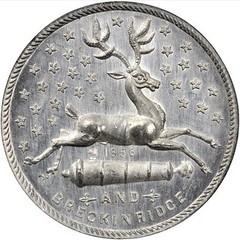
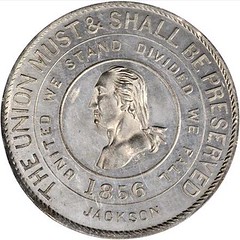
1856 Buchanan and Breckinridge "Buck-Cannon" Campaign Medal. First Obverse. White Metal. 46 mm. Baker-380A, Musante GW-155, DeWitt-JB 1856-2. Rarity-8. MS-63 (NGC).
A simply outstanding example of this highly elusive and eagerly sought type. Both sides exhibit lovely pewter gray color, the reverse especially prooflike in finish. Fully Choice in quality with a sharp strike and abundant eye appeal. Baker-380A (and its bronze counterpart Baker-380) is considered a classic rarity in both the Washingtoniana and political Americana fields. Not represented in our Ford XXIV sale of September 2013, and of the utmost importance to specialists.
To read the complete lot description, see:
1856 Buchanan and Breckinridge "Buck-Cannon" Campaign Medal. First Obverse. White Metal. 46 mm. Baker-380A, Musante GW-155, DeWitt-JB
(https://auctions.stacksbowers.com/lots/view/3-6Y3G4)
Lot 72: 1909 Lincoln Centennial Preserve, Protect, Defend Medal
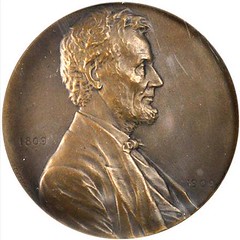
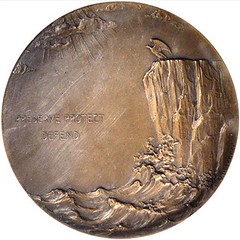
1909 Lincoln Centennial Preserve, Protect, Defend Medal. Bronze. 63 mm. By Victor David Brenner. Cunningham 24-270, King-303, Smedley-84. MS 66 BN (NGC).
Certainly one of the more dramatic medals produced for Lincoln's birth centenary in 1909, and apparently a rare variety as well. According to Paul A. Cunningham in the 2015 reference Lincoln's Metallic Imagery, only 20 specimens were struck with the artist's signature appearing as V.D. BRENNER at about 8 o'clock on the obverse before the die broke. New dies were prepared replacing his name with just the initials VDB moved to the truncation of Lincoln's bust in just about the same position they would be on all Lincoln cents produced from 1918 to date. Produced as a "desk medal" by Gorham Co. for Brenner, this is a visually impressive and rare piece in any of its varieties. Incorrectly attributed on the NGC insert as King-304.
To read the complete lot description, see:
1909 Lincoln Centennial Preserve, Protect, Defend Medal. Bronze. 63 mm. By Victor David Brenner. Cunningham 24-270, King-303, Smedley-84...
(https://auctions.stacksbowers.com/lots/view/3-6Y33J)
Lot 4109: Atwater Correspondence on Stickney 1804 Dollar
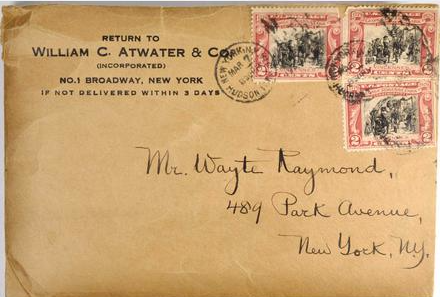
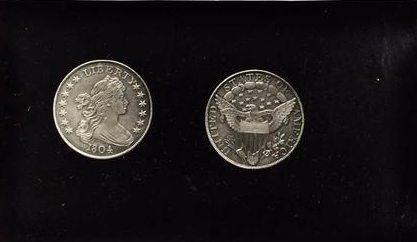
Correspondence Between William C. Atwater and Wayte Raymond Concerning the Stickney Specimen of the 1804 Silver Dollar. This lot consists of a single page letter from William C. Atwater to Wayte Raymond, the associated mailing envelope, and 11 photographs, each depicting both sides of an 1804 dollar. The letter reads:
"My dear Raymond! Here are all the photos I have of my Stickney dollar. I am sending all of them to you that you may select the best for your purpose. They look pretty good to me and seem to show of[f] the individual characteristics of the coin. Please return to me the pictures you do not use. Atwater."
The letter has been folded once to fit into the envelope; otherwise it is in excellent condition. The mailing envelope bears Atwater's printed business address and is addressed to Wayte Raymond in New York City. The postal cancellations bear the date of March 7, albeit without the associated year. The three two-cent stamps affixed are 1929 George Rogers Clark commemoratives, which probably give a good indication of the year of mailing. The back flap of the envelope has become detached, but is still present. The photographs show the coin in different lighting conditions and on light and dark backgrounds, and are all in excellent condition. The two cardboard stiffeners to protect the photographs are still present.
The coin in question is probably the most famous coin in the world. It was the first 1804 dollar to enter the numismatic marketplace, having been acquired by Matthew Adams Stickney in a trade with officials at the Philadelphia Mint in 1843. It remained in the Stickney collection until 1894 and, upon his death, passed into the hands of his daughter. In 1907 the collection, including the 1804 dollar, was auctioned by Henry Chapman. The purchaser was Colonel James W. Ellsworth, who held the coin until 1923 when Wayte Raymond dispersed the Ellsworth collection. The purchaser this time was William C. Atwater. Shortly after the sale, this letter was sent to Raymond, who wanted a photograph of the coin for "purposes" unclear in the letter.
To read the complete lot description, see:
Correspondence Between William C. Atwater and Wayte Raymond Concerning the Stickney Specimen of the 1804 Silver Dollar.
(https://auctions.stacksbowers.com/lots/view/3-6Y9RS)

MAN ARRESTED CARRYING ANCIENT COINS INTO ISRAEL
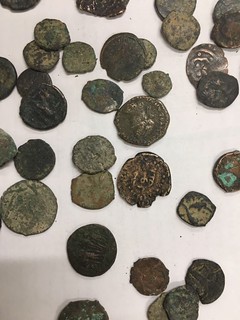 Israeli customs authorities stopped a Palestinian man for allegedly attempting to smuggle several dozen ancient coins into the West Bank from Jordan.
Israeli customs authorities stopped a Palestinian man for allegedly attempting to smuggle several dozen ancient coins into the West Bank from Jordan.
The man was crossing from Jordan into the West Bank through the Allenby Bridge last week and was found to be in possession of 53 coins dating from the first century BCE to the 13th century CE, the Defense Ministry’s Coordinator of Government Activities in the Territories said Monday.
A customs official asked him to empty his pockets and noticed a bag of coins. The suspect, identified only as a man from the city of Tulkarem, was arrested by Israeli police and the coins were transferred to the Civil Administration’s archaeology staff officer.
A spokeswoman for the police said the suspect was released from custody and that the case was under investigation. The suspect told officers that he purchased the coins in Jordan, but that he wasn’t an antiquities dealer.
“I am glad to see that once again the cooperation between all officials had prevent the theft of the history of all of us,” said Benny Har-Even, deputy archaeology coordination officer in the IDF’s Civil Administration, the agency charged with managing civil affairs for the IDF in the West Bank.
Har-Even declined to provide additional information about the coins, except saying that they ranged from the Roman to Mamluk eras. The artifacts will remain in the Civil Administration’s custody for study, a COGAT spokesperson said.
To read the complete article, see:
Palestinian nabbed at crossing with sack of ancient coins
(www.timesofisrael.com/palestinian-nabbed-at-jordan-crossing-with-sack-of-ancient-coins/)
MCDONALD'S FEATURES AN ANCIENT ROAD
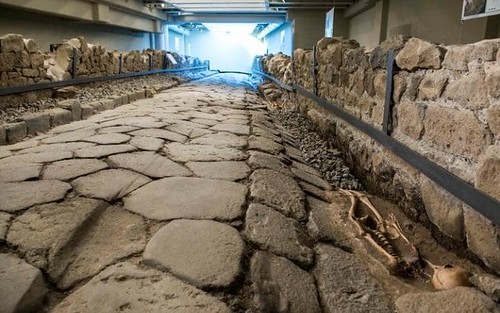
Two thousand years after legionaries tramped along its well-worn paving stones, an exceptionally well-preserved stretch of Roman road has been opened to the public – beneath a McDonald’s restaurant.
In what the American burger chain says is its first museum-cum-restaurant anywhere in the world, the 150ft-long stretch of basalt road has been cleared, cleaned and made into a permanent attraction at Frattocchie, south of Rome.
Customers in search of a little cultural heritage along with their Big Macs and fries can descend underground and view the Roman road, as well as three ancient skeletons that were found buried in the culverts either side of it.
A transparent pavement means they can even peer down into the archaeological area while slurping milk shakes and munching McNuggets.
The unusual find came to light in 2014 when the area was being excavated for a new McDonald’s restaurant. Archaeologists were summoned and the US fast food chain contributed 300,000 euros to the three-year restoration of the site.
Experts say the paved road connected with the Appian Way, one of ancient Rome’s most important thoroughfares, which led from the capital to Brindisi on the Adriatic coast.
The stretch of road is about 150ft long and more than 7ft wide. It was built in the 2nd century BC but fell into disuse by the 3rd century AD and remained buried for more than 1,700 years. The bodies are believed to have been buried in the period after the road was abandoned.
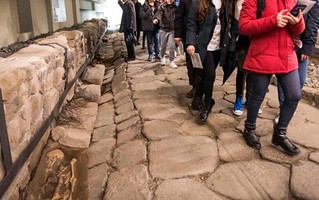 “The skeletons belong to three men, the oldest of whom was aged 35-40,” said Pamela Cerino, an archaeologist who worked on the dig.
A fourth skeleton was discovered beneath a nearby petrol station. Archaeologists found a coin in the person’s mouth, believed to be an offering to Charon, the ferryman of Roman mythology who carried the dead across the River Styx into Hades.
“The skeletons belong to three men, the oldest of whom was aged 35-40,” said Pamela Cerino, an archaeologist who worked on the dig.
A fourth skeleton was discovered beneath a nearby petrol station. Archaeologists found a coin in the person’s mouth, believed to be an offering to Charon, the ferryman of Roman mythology who carried the dead across the River Styx into Hades.
Signs in English and Italian explain the history of the road and its discovery. It is accessible from the McDonald’s car park, so visitors do not have to eat in the restaurant to explore the newly-opened site.
To read the complete article, see:
(www.telegraph.co.uk/news/2017/02/22/want-ancient-roman-heritage-stretch-roman-road-unveiled-beneath/)
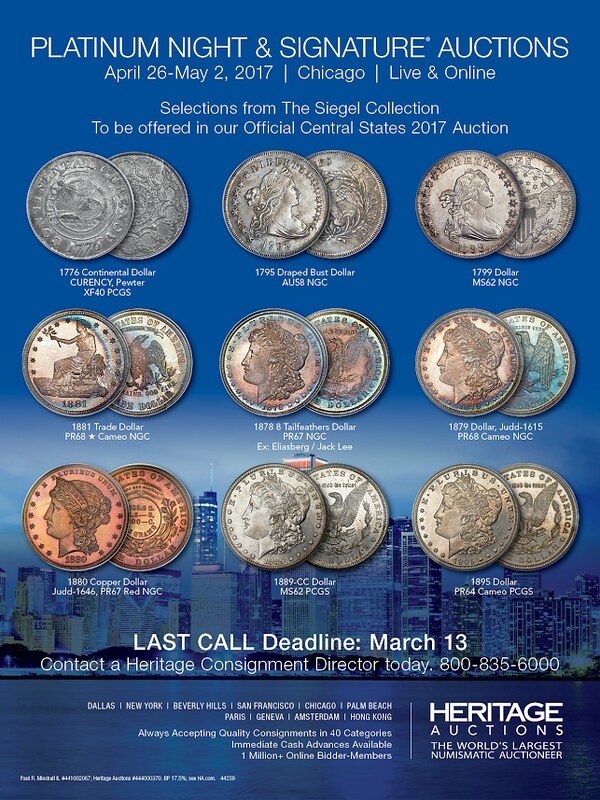
DETECTORIST FINDS RARE GOLD ANGEL OF EDWARD V
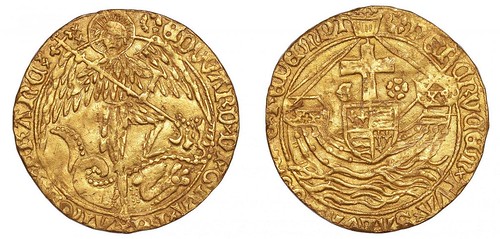
A METAL detectorist from Bournemouth has discovered an “extremely rare” gold coin dating from the brief reign of Edward V, which is expected to fetch up to £15,000 at auction.
When heating engineer Brian Biddle found The Angel coin in a field at Tolpuddle, he initially thought it was a bottle top.
The 64-year-old quickly realised that he had come across a gold coin and shared the discovery with fellow members of the Stour Valley Search and Recovery Club.
He registered the find at Dorchester Museum and subsequent research into the coin – which features an image of the Archangel Saint Michael slaying a dragon – has revealed it was minted during the reign of 12-year-old Edward V who reigned for just 86 days in 1483.
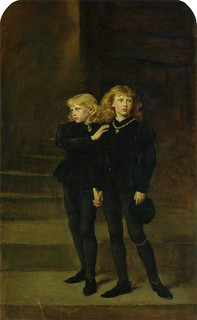 Edward, one of only four English monarchs never to have been crowned, and his younger brother Richard, Duke of York, then vanished into a dungeon in the Tower of London.
Edward, one of only four English monarchs never to have been crowned, and his younger brother Richard, Duke of York, then vanished into a dungeon in the Tower of London.
It has always been widely believed that they were murdered on the orders of their uncle, who then succeeded Edward as Richard III.
The coin will be auctioned by Dix Noonan Webb in London on Wednesday, March 15.
Mr Biddle, who has only been a detectorist for 18 months, said: “I was fortunate to find this. “It was about four or five inches down and at first I thought it was a bottle top as we find a lot of things like that.
“Once I got it out of the ground I realised it was a gold coin.”
Peter Preston-Morley, a coins expert at Dix Noonan Webb, said: “This coin is important partly because it is extremely rare but also because it is a link to one of the greatest mysteries in English history.
“The story of the ‘little princes in the tower’, as they have become known, still fascinates us more than 500 years later and arguments over whether or not Richard was responsible for their deaths are still going on.”
Richard, Duke of Gloucester, ordered the boys’ imprisonment and then seized the throne as Richard III on June 26, 1483. Shortly after that the dies used to mint coins were altered to read RICARD DI GRA and the mint mark was overstruck with Richard’s personal emblem, a boar’s head.
The boys’ exact fate is unknown but the most popular theory is that they were smothered with their pillows on the orders of their uncle, and this forms the basis of William Shakespeare’s play Richard III.
The Angel found in Tolpuddle miraculously survived repeated ploughing by farmers down the centuries to emerge in good condition 533 years after it was minted.
To read the complete article, see:
Bournemouth metal detectorist discovers "extremely rare" coin from Edward V's reign (and it's worth £15,00
(www.bournemouthecho.co.uk/news/15131047.The____extremely
_rare____gold_coin_that_metal_detectorist_thought_was_a
_bottle_top__and_it___s_worth___15_000_/#)
THE BOOK BAZARRE
CURIOUS UNDERWEIGHT 1983 CENT FOUND
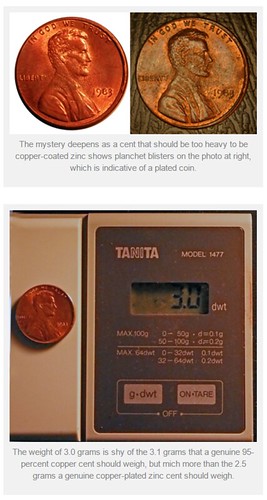 Numismatic News reader Howard Sawicki has reported finding a 1983 cent that weighs 3.0 grams.
Numismatic News reader Howard Sawicki has reported finding a 1983 cent that weighs 3.0 grams.
The presumption in a case like this is that it must be copper, something it shouldn’t be because all cents were supposed to have been made of copper-coated zinc in that year.
The weight of 3.0 grams is shy of the 3.1 grams that a genuine 95-percent copper cent should weigh, but much more than the 2.5 grams a genuine copper-plated zinc cent should weigh.
However, the weight is too light. There the mystery deepens.
In the last few weeks I’ve shown the first known 1982-D Small Date cent struck on a Pre-82 US cent planchet that weighs the correct 3.1 grams and I’ve shown a 1983-D cent that weighs a light 3.0 grams. Both were authenticated by Numismatic Guaranty Corporation as struck on solid copper alloy planchets. However the 1983-D weighed 3.0 grams and was identified as being of a 92 percent copper alloy rather than the 95 percent copper 5 percent zinc alloy – out of specifications on both counts for a pre-1982 planchet.
The latest cent dated 1983 is as mysterious as the 1983-D of which nobody knows exactly what it represents. However, in this case there does appear to be planchet blisters, which are diagnostic of a copper-plated zinc cent, but I have no explanation for the weight being so much over the normal 2.5 grams.
It could be struck on an unidentified foreign planchet or it could it be a wayward pre-1982 planchet that was inadvertently plated if such a thing exists. Of course it could simply be struck on a thick planchet – I just don’t know at this point, but I can say I’ve never seen a copper-plated zinc planchet weighing this far out of specifications.
To read the complete article, see:
Search goes on for errors in copper
(www.numismaticnews.net/article/search-goes-errors-copper)
To read the earlier E-Sylum article, see:
BRONZE 1982-D SMALL DATE CENT ERROR DISCOVERED
(www.coinbooks.org/v20/esylum_v20n08a18.html)
ANOTHER CALL TO END U.S. CENT PRODUCTION
Dick Johnson writes:
Are we closer to axing the cent? A letter to the editor in the Atlantic City Press wants the government to cease striking cents. Good idea. He also suggests closing one of the country’s three mints because that would cut their coin production in half. Bad idea.
End pennies, save money
Are pennies worth the trouble? Data from the U.S. Bureau of Labor Statistics shows that the purchasing power of one cent in 1913 was approximately equal to that of today’s quarter. In 1913, the cent was the lowest denomination coin and today it still is. Over 2.5 billion pennies were struck (2014-2016) and comprised 55 percent of the total coins minted. Estimates of the cost to produce and distribute pennies range from 1.7 to 2 cents each and the Treasury loses $100 million yearly by continuing to produce these nearly worthless coins.
Canada stopped minting pennies in 2012, and it’s time that the U.S. does likewise. This action would halve U.S. coin production and could justify consolidating coin manufacturing from three mints to two. Given the country’s ballooning deficit, it makes perfect economic sense for the U.S. Treasury to abandon nostalgia and end deficit-enhancing penny production.
Tom DeFiore
Hammonton
To read the complete article, see:
(www.pressofatlanticcity.com/opinion/letters/voice-of-the-people-feb/article_e88c94be-10be-50b8-9e08-045070c177cc.html)
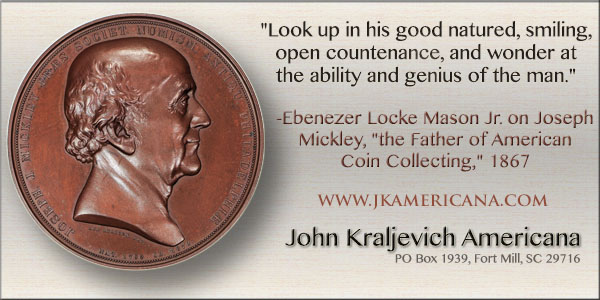
THE 1976 U.S. BICENTENNIAL COINAGE
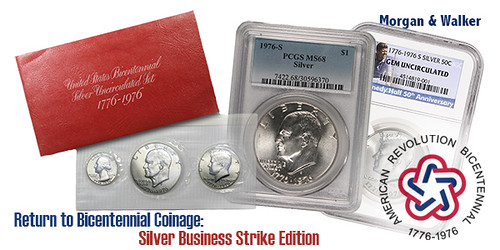
One of the first pieces that we wrote for CoinWeek discussed Bicentennial quarters. In it, we discussed the nuances of the issue, from strike to Mint State grade distribution of the P- and D-mint coins by PCGS and NGC. We also questioned whether the coin would ever see an appreciable rise in value (spoiler alert: it hasn’t yet). Regardless, when we wrote it, we felt that modern coin collectors would benefit from the kind of in-depth analysis that is generally reserved for “investment-grade” classic numismatic coins.
Today, we’d like to return to the topic of America’s Bicentennial coinage and discuss the silver-clad three coin Uncirculated set - a perennial favorite for collectors of modern U.S. coins.
The Bicentennial Silver Three-Coin Uncirculated Set was struck starting in February 1975 and continuing through to June 22, 1976, according to Walter Breen. Q. David Bowers writes in his A Guide Book of Modern United States Dollar Coins that federal law required the U.S. Mint to be finished with silver Bicentennial coin production by July 4 of that year. As the production window closed, the Mint (expecting huge demand) made the decision to dramatically increase the number of sets made by running the coins through at high speed.
They probably shouldn’t have bothered; it is estimated that of the 11 million sets produced, only 4,908,319 sets were sold.
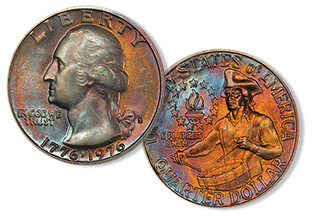 Demand for the issue, which had an initial offer price of $9 ($7 in bulk), dried up soon after the Bicentennial celebrations came to a close, but that didn’t stop the Mint from offering the overproduced set in its annual catalog until the end of 1986.
Demand for the issue, which had an initial offer price of $9 ($7 in bulk), dried up soon after the Bicentennial celebrations came to a close, but that didn’t stop the Mint from offering the overproduced set in its annual catalog until the end of 1986.
Two Types of Collector Demand
There are two types of collector demand for modern coins: demand for raw coins (coins as issued) and demand for certified coins (coins graded by a third-party service like NGC or PCGS).
For raw coins, grade on uncirculated coins in original mint packaging (or even broken up and put in individual after-market coin flips or 2x2s) is of little consequence. Collectors typically prefer coins with good eye appeal, but will generally accept a complete set in its original packaging as sufficient for their needs. To this type of collecting, a Bicentennial Silver Three-Coin Uncirculated has a value of whatever the prevailing market price is for a complete set.
In other words, $13-$14, based on today’s market price.
For collectors who prefer certified coins, the “value” of the sets is much more nuanced because the goals of this collector are markedly different. Certified coin collectors seek to commoditize quality.
To read the complete article, see:
Return to Bicentennial Coinage: Silver Business Strike Edition
(www.coinweek.com/modern-coins/return-to-bicentennial-coinage-silver-business-strike-edition/)
For more information on Jack Ahr and his quarter, see: Jack Ahr Design, Inc. (www.jackahrdesign.com/TheBicentennialQuarter/)

A MYSTERY UNITED NATIONS GOLD PATTERN
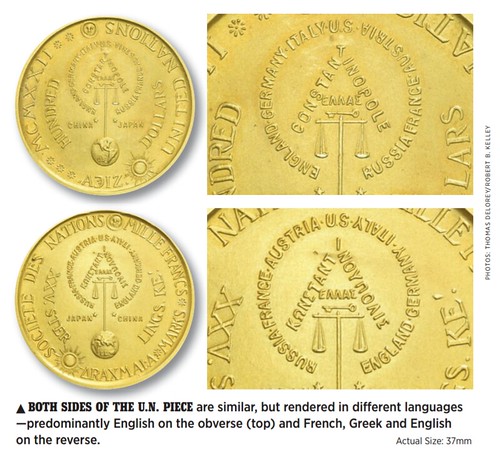
In 1951 numismatic author Richard D. Kenney published a trial listing of “Unofficial Coins of the World” in The Coin Collector’s Journal, listing apocryphal issues from such non-coin-producing entities as Patagonia and the Republic of New Mexico. He wrote many other excellent numismatic articles in the 1950s, including the seminal work on “so-called dollars” in 1953, and had prepared an expanded “Unofficial Coins” manuscript before his untimely death in late 1956. The numismatic firm for which he worked honored his expressed wish that the manuscript be submitted to The Numismatist, which in 1960 began soliciting artwork for the article from a wealth of collectors, dealers, numismatic societies and museums. The first part appeared in the June 1962 issue with an “Author’s Preface,” plus an “Editor’s Preface” by Elston G. Bradfield.
Nineteen unofficial issues, some of them in related groups, were included in the first segment under the subhead “International,” after which the rest of the catalog was published at irregular intervals into 1964.
Today the subject matter is the nucleus of a large and very popular book Unusual World Coins (ANA Library Catalog No. C87 .B7u 2011), edited by George S. Cuhaj.
Kenney began with the Eutopia dollar of 1886 and the Bickford dollars of 1897. The U.S. talents of 1896 were followed by Thom as Elder’s Henry Hudson daalders of 1909 and Brian Boru crowns of 1910. These U.S. collectibles were succeeded by the truly international Esperanto spesmilos of 1912 and Kenney-13 — the mysterious “United Nations 100 Dollars 1922.”
There was no illustration, just this cryptic note: “Apparently a gold and/or silver League of Nations pattern based upon a plaster cast in the cabinet of the American Numismatic Society, New York, N.Y. Attempts to locate a specimen have thus far proved fruitless.”
The U.N. Specimen
The piece apparently remained
unknown to the numismatic
world until February 2016, when
a man walked into a coin shop
in the Atlanta area with seven
examples of what later turned
out to be Kenney-13, struck in
gold.
The store owner showed one to former ANA Governor Bill Fivaz, who sent pictures of it to authors and U.S. coinage experts Q. David Bowers, Kenneth E. Bressett and myself. None of us were familiar with the piece, so I shared the photos with noted numismatist David T. Alexander. He suggested looking in Kenney’s works, where I found it thanks to the new digital archives of The Numismatist.
ANA members can read the complete issue online here:
https://www.money.org/digital-magazines
QUERY: 1896 ARGENTUM UNIVERSALE ISSUES
I'm familiar with the 1886 Eutopia dollar and the 1897 Bickford dollars, but was unfamiliar with the 1896 talents mentioned in the previous article by Tom DeLorey. A search of The Numismatist archives provided a few hits.
May 1934, p336: "one Talent Argentum Universale, United States of America 1896"
March 1910, p85: "Mr. Woodin, as usual, had several rare patterns of the highest interest, among them a proof of the "United States 'Talent' " of 1896, bearing on obverse and reverse the opposing hemispheres of the globe, with "UNITED STATES OF AMERICA"
These are not listed in Adams-Woodin or Judd as official patterns of course, but I checked anyway. I did find two short listings in the 5th edition of Unusual World Coins, p545. The entries for 1/5 Talent (x# 1) and Talent (X# 2) are unillustrated and marked "reported, not confirmed."
So... can anyone point me to more information on these enigmatic pieces? Thanks. -Editor

SOUTH AFRICA "ZULU" MEDAL BRINGS RECORD PRICE
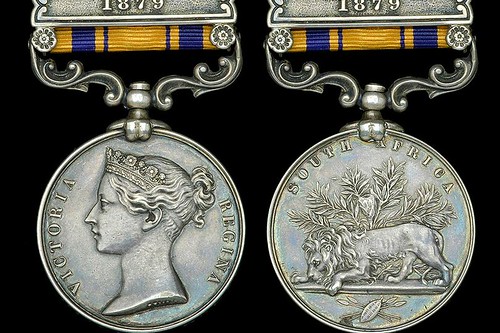
A medal awarded to one of the defenders of Rorke's Drift, which was immortalised in the film Zulu, today sold for a record £132,000.
Driver Charles Robson was the batman, or personal servant, to Victoria Cross hero Lieutenant John Chard, who was played by Stanley Baker in the classic 1964 movie.
The duo formed part of the 140-strong British garrison which defied all odds to successfully defend the Rorke's Drift mission station from 4,000 marauding Zulu warriors in 1879.
Robson never left the side of Lt Chard, who was the commanding officer and who organised the epic defence.
For 12 hours the British repelled the spear-carrying tribesmen with accurate shooting and brutal hand-to-hand combat. The Zulus retreated with 350 of their number killed compared to 17 British.
Lt Chard was awarded the Victoria Cross - the highest award for valuer in the face of the enemy - as was Lt Gonville Bromhead, who was played by Michael Caine in the film.
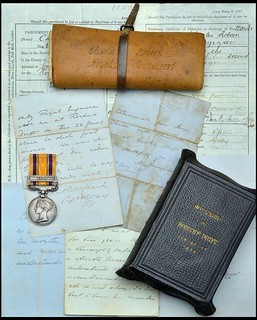 Robson received the Zulu War medal which today sold for a hammer price of £110,000. With fees added on the overall price paid by the private telephone bidder was £132,000.
Robson received the Zulu War medal which today sold for a hammer price of £110,000. With fees added on the overall price paid by the private telephone bidder was £132,000.
The staggering sum is a record for a non-VC Rorke's Drift medal.
It easily beat the existing record of £84,000 paid for the Zulu War Medal of private Michael Minehan last December.
A spokesman for London auctioneers Dix Noonan Webb said: "The extra price reflects the fact that the defence of Rorke's Drift is still regarded as one of the most heroic episodes in British Military History.
"Medal collectors tend to like a great story behind their medals and stories don't get much better than Rorke's Drift. It remains one of the most epic actions in military history."
To read the complete article, see:
Zulu War medal of Rorke's Drift hero sells for record £132,000 at auction
(www.mirror.co.uk/news/uk-news/zulu-war-medal-rorkes-drift-9950274)
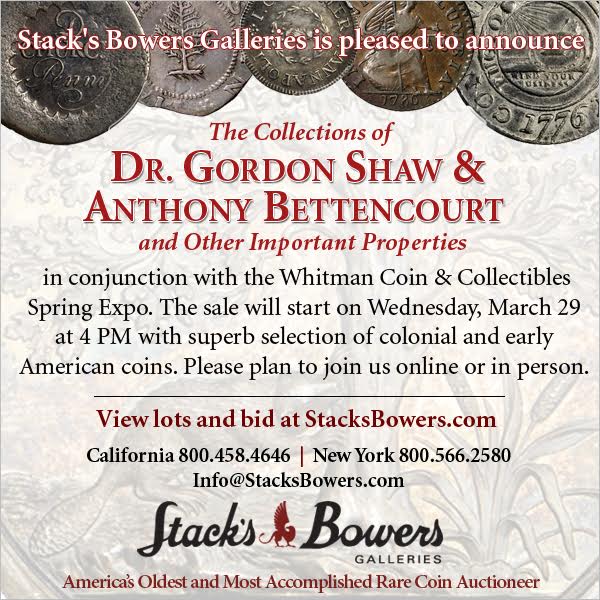
BEWARE OF HOBO NICKEL COPIES
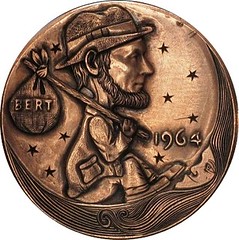
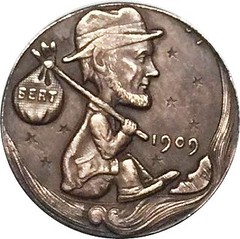
Left: Paolo Curcio Original. Right: Fake
As hobo nickels gain in popularity, so too is some threat of unscrupulous people selling knockoffs. That very thing happened in the last months of 2016. A few “hobo nickels” coming out of China hit the market and they were direct copies of carvings made by some talented artists. I first recognized a design that Paolo Curcio had done on an off center penny. I emailed a few OHNS board members to alert them and then I posted listings from two separate sellers on our Facebook page. I was hoping that any of the bidders on the copies would be able to retract bids, or stop bidding further, or complain to eBay. Enough complaints were filed that the listings were ended but then the items were relisted. I have watched one of the sellers and there has not been any recent activity from that seller but there are new sellers now too.
The first listings were misleading and did not state that they were cast or struck copies. Also, images were pirated without permission from the artists. Recently I noticed more of these same copies being sold from a St. Louis, MO address. They are under a different account than the ones from China. In the title of these newer listings, there is no notation of them being copies or token issues but if one were to read down to the description part, it does describe that they are pressed coins. This is a perfect example of why it is important to read an entire listing before clicking on the bid button.
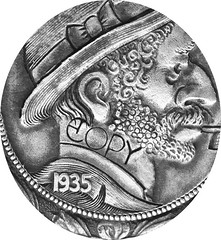 Besides making sure a copy
is clearly identified in a
listing, it is best that artists
making their own copies
should also mark the coins
as such. I bought a copy of
Aleksey’s 25 th anniversary
Morgan dollar carving and
noticed that he clearly
marked copy in fairly large type on one side of the
coin. Ron Landis also marked U.S. and ancient coin
copies when he ran the Gallery Mint. A copy mark on
the edge of a coin is not recommended as it can be
smoothed off by a person later on down the road.
Besides making sure a copy
is clearly identified in a
listing, it is best that artists
making their own copies
should also mark the coins
as such. I bought a copy of
Aleksey’s 25 th anniversary
Morgan dollar carving and
noticed that he clearly
marked copy in fairly large type on one side of the
coin. Ron Landis also marked U.S. and ancient coin
copies when he ran the Gallery Mint. A copy mark on
the edge of a coin is not recommended as it can be
smoothed off by a person later on down the road.
There is also a seller on eBay making epoxy resin hobo nickel copies and mounting them in bezels made from coins. The seller has obtained artist permission and does list them in the description as copies. Just remember it is always important to read the fine print in the listings because looking only at the photos can be misleading. The title does not sum everything up either, so always read the descriptions.
Carol adds:
I post them on OHNS Facebook when I find them and then our members unite together and report them to ebay. We have had some success in getting ebay to take down a listing here and there but the sellers relist again or maybe even use a different account the next time. At least by putting them on FB it can help many collectors from getting taken. Social media does a lot of good with our interconnectedness.
For more information about the Original Hobo Nickel Society, see:
www.hobonickels.org

STOP AND SMELL THE BOOKS
David Sundman writes:
Fellow book lovers may find this article on capturing the aroma of old books using the 1906 Morgan Library as a case study, of some interest. As you know financier J. P. Morgan was quite a collector of coins.
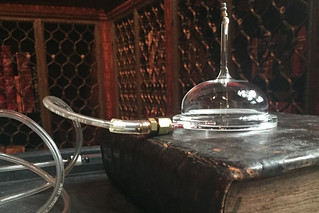 Over the past year, a Columbia University preservation expert and a curator at the Morgan Library & Museum in Manhattan have been engaged in an unusual poetic-scientific experiment in the little-visited olfactory wing of history, trying to pin down the powerful connection between smell and memory — in this case, collective memory.
Over the past year, a Columbia University preservation expert and a curator at the Morgan Library & Museum in Manhattan have been engaged in an unusual poetic-scientific experiment in the little-visited olfactory wing of history, trying to pin down the powerful connection between smell and memory — in this case, collective memory.
“People in my field are interested in what makes buildings significant,” Jorge Otero-Pailos, professor and director of historic preservation at Columbia, said in an interview on Wednesday. “In fact, people’s memories are what make buildings culturally significant. And smell is the most direct way to those memories, but we pay so little attention to it.”
Over the last year, he and seven graduate students have been conducting a project in collaboration with Morgan, with the help of Christine Nelson, curator of literary and historical manuscripts at the library.
Their goal is perhaps someday to be able to convey a sense of the building’s history beyond just its look and feel. Their primary tool is a sampling device that looks like a contraption out of Jules Verne: a crystalline dome with plastic tubing snaking from its side.
The sampler is placed gently on objects — rare books, furniture, carpets — to capture the escaping molecules that create a distinct smell.
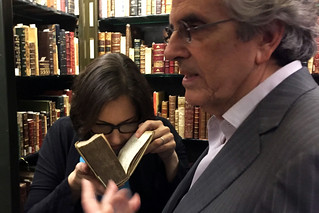 During visits to the library late last month, the class went spelunking with Ms. Nelson through the vermilion-hued private study of John Pierpont Morgan, the financier and collector who built the library in 1906, on Madison Avenue near 36th Street, to house his immense trove of rare books and art. (The library’s three buildings were united with a modern addition by Renzo Piano in 2006.)
During visits to the library late last month, the class went spelunking with Ms. Nelson through the vermilion-hued private study of John Pierpont Morgan, the financier and collector who built the library in 1906, on Madison Avenue near 36th Street, to house his immense trove of rare books and art. (The library’s three buildings were united with a modern addition by Renzo Piano in 2006.)
“Under normal circumstances, we would have been kicked out of any museum if were behaving the way we behaved: We were on all fours, putting our heads under Morgan’s desk, smelling his cigar box, the aromas inside his personal book vault, which were still very strong,” said Mr. Otero-Pailos, who has been exploring the role of smell in preservation for almost a decade.
Ms. Nelson, who has worked at the Morgan for 26 years, said: “One of the reasons I was very drawn to working with this project was that for years people have come to me and said: ‘Oh God, it must smell so great where you work! I remember that old book smell from my favorite library so well.’ Everybody has some sort of olfactory memory of a library that probably had an effect on their lives.”
She added: “For me as a librarian, I’ve always thought about the question: Is there really a single old-book smell? I feel very strongly that there’s not, and now I’m going to get to see the proof.”
That proof is being percolated over the next few months in a Manhattan lab at International Flavor and Fragrances, a company that produces smells and tastes for everything from colognes to detergents and candies.
Besides books like a 16th-century calfskin-bound volume of Jacobus de Voragine’s “The Golden Legend,” what does a shelf of Circassian walnut that Morgan undoubtedly drew volumes from smell like? Or a box of his cigars, Havanas by Pedro Murias, circa 1910? Or a 1905 Otis elevator?
For that matter, what might these things have smelled like during Morgan’s time or, for the rare volumes, centuries ago when they were new from the printer and binder? And could there be some Gilded-Age perspiration still lingering somewhere in the mix? During the 1907 financial panic, Morgan famously locked a group of bankers in the library overnight to force them to come to an agreement to save the economy.
To read the complete article, see:
What’s That Smell? Rare Books and Artifacts From a 1906 Library
(www.nytimes.com/2017/03/03/arts/morgan-library-book-smell.html)
“There is no single old book smell, and I associate that typical smell with a book that hasn’t been in a stable environment,” said Christine Nelson, curator of literary and historical manuscripts at the Morgan Library & Museum. And stability is a major concern for the Manhattan institution with its incredible collection of books dating back to the fifth century. Nelson and a group of students from the Columbia Graduate School of Architecture, Planning and Preservation (GSAPP), who gathered in the Morgan’s conservation lab, were deeply inhaling the scents of a selection of old books to consider what the place may have smelled like way back in 1906, the year that John Pierpont Morgan’s stately McKim, Mead and White-designed library was completed.
And whether or not the windows were open in J. P. Morgan’s day was on the mind of Jorge Otero-Pailos, who is teaching this experimental historic preservation class. Street smells from Gilded Age New York could have wafted through the windows, mingling with the collection of rare tomes from across various eras, and the cigar puffing of Morgan himself. “I try to get students to rethink how we can preserve objects in a creative way that reengages people with those objects,” he said.
“The smell of a room can bring you to that room faster than a picture,” Benaim remarked. To create what he called a “reconstruction of an epoch,” the students and researchers are delicately capturing the smells of different objects and historic areas of the 1906 Morgan. They’ve descended to the basement, with its antique Otis elevator works, examined the fireplace, and climbed up to a 16th-century tapestry, which is the only textile known to date to J. P. Morgan’s time. Their main tool, in addition to their curious noses, is a small glass dome that can gently rest on a centuries-old book without damaging it, collecting its character with molecules on a wax needle (a technique known as headspace technology). “The bell acts as a way of concentrating what is there,” Benaim explained. “It can pick up parts per billion of ingredients in the atmosphere.” Otero-Pailos said that it was so precise “none of us could wear cologne that day.”
For now, the project is in its experimental phase. Ultimately, Otero-Pailos hopes to generate a methodology that could be replicated, as currently most olfactory practices relate to the perfume industry. As Nelson pointed out, the “end product is not the entire purpose.” Rather, it’s this idea of rethinking relationships to space through smell, and she affirmed as a longtime employee at the Morgan, it’s been a powerful reconnection to her early days at the museum. “Revisiting its old nooks and crannies, it has for me conjured a lot of memories,” she said. “It’s a living space, and it’s an evolving space.”
To read the complete article, see:
Researchers Bury Their Noses in Books to Sniff Out the Morgan Library’s Original Smell
(http://hyperallergic.com/360698/smelling-the-old-books-of-the-morgan-library/)
THE OLDEST U.S. LETTERPRESS TYPE FOUNDRY
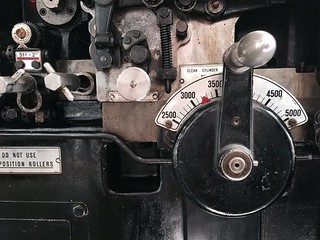
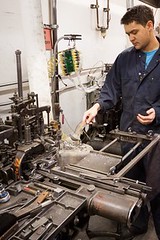
The M & H Type foundry continues to make physical fonts the old-fashioned way, by pouring them out of red hot metal. Located in San Francisco’s beautiful Presidio, the foundry shares a roof with one of the most vintage typesetters, Arion Press, and you can get a tour of the printing process from start to finish.
Founded in 1961, Arion made its name publishing Beat-era books and classics printed in period-authentic type. Today, it publishes three to four new books each year, in limited editions, using letterpress and custom illustrations all with zero computer involvement. A gallery in the lobby showcases some of the recent and older books and prints. A public tour is even more interesting: Visitors are walked through the typesetting area where you can see vintage presses, rollers, and letters being strung together to form words, and then whole pages.
Further along, tours descend to the basement to see the alchemical process of actually making the individual letters out of the foundry. The tour ends where the bookmaking process does, when the paper is inspected and the volumes are bound.
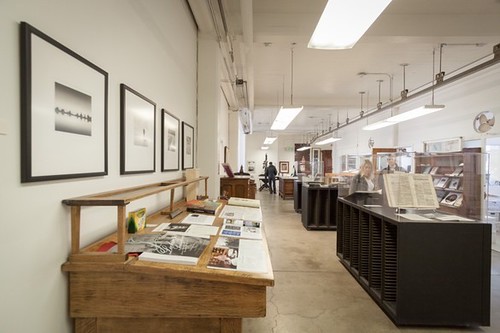
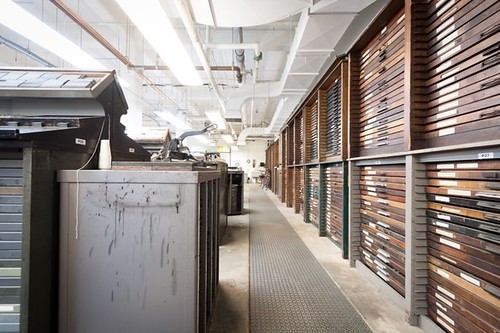
To read the complete article, see:
Arion Press and M & H Type
(www.atlasobscura.com/places/arion-press-and-mh-type)
